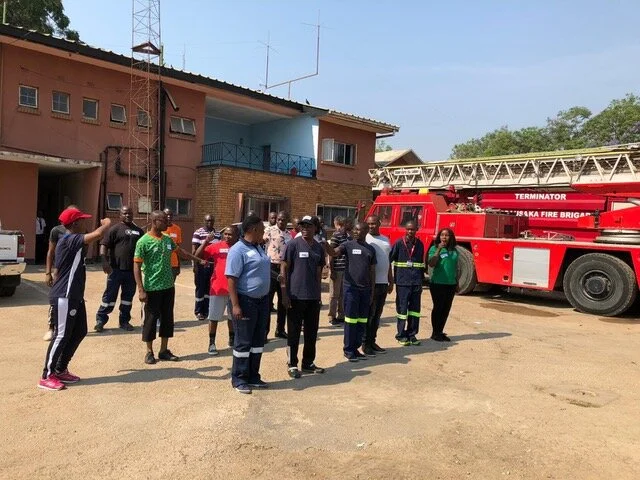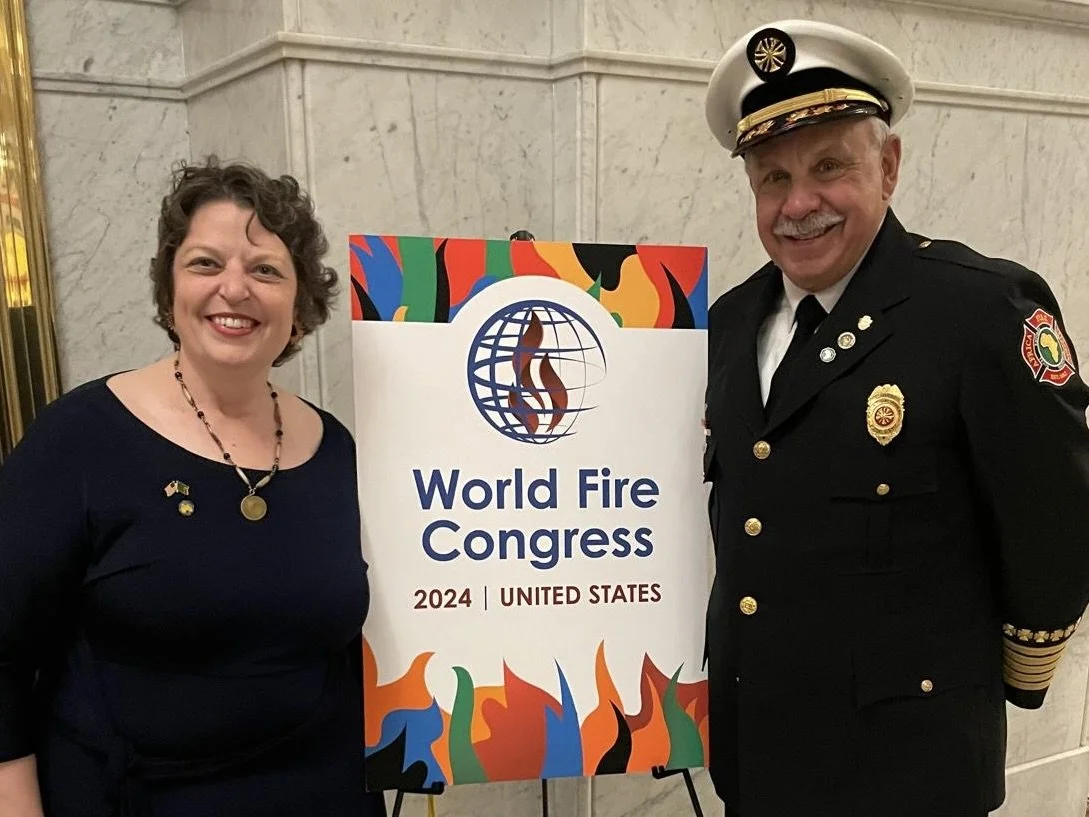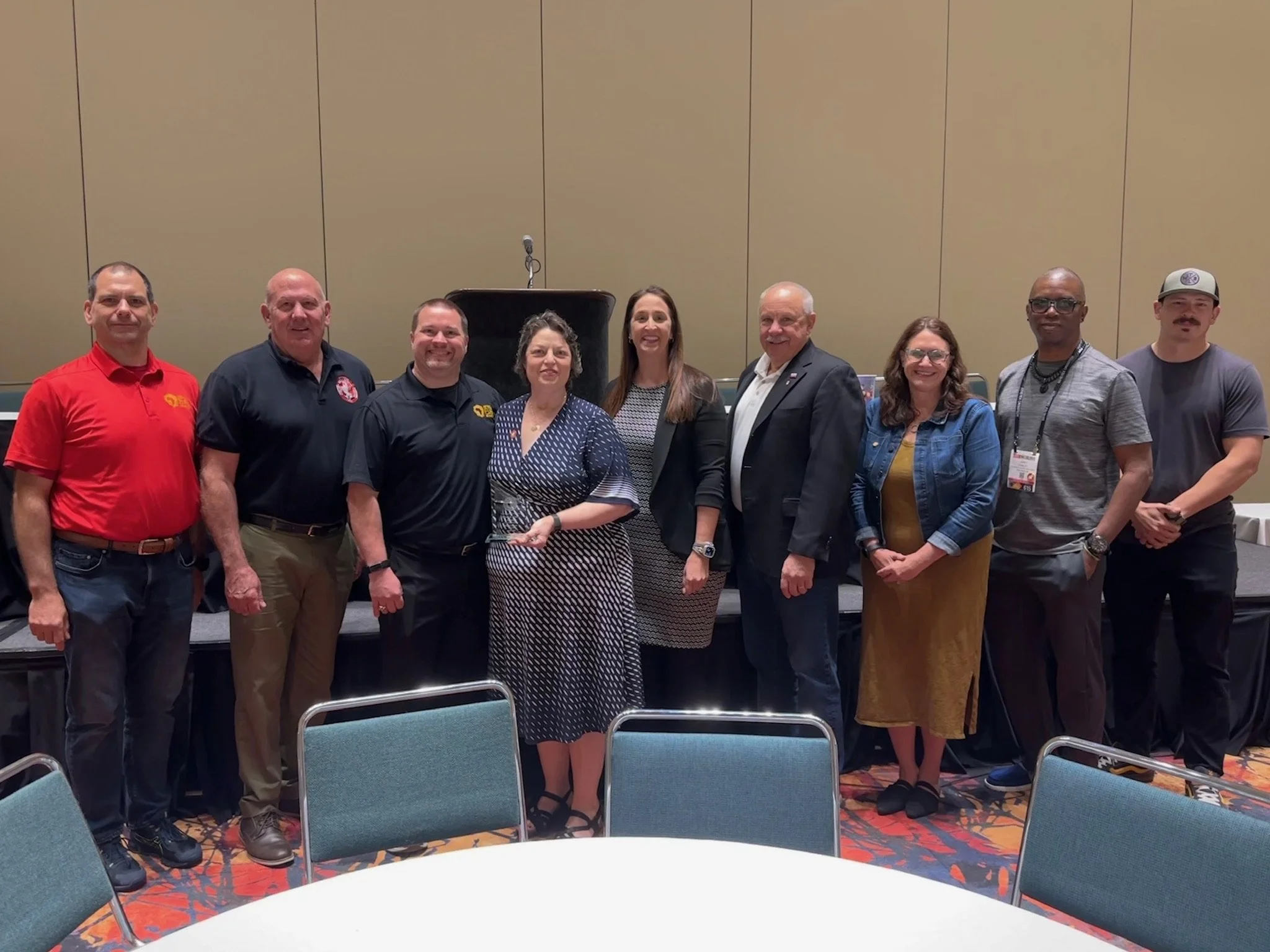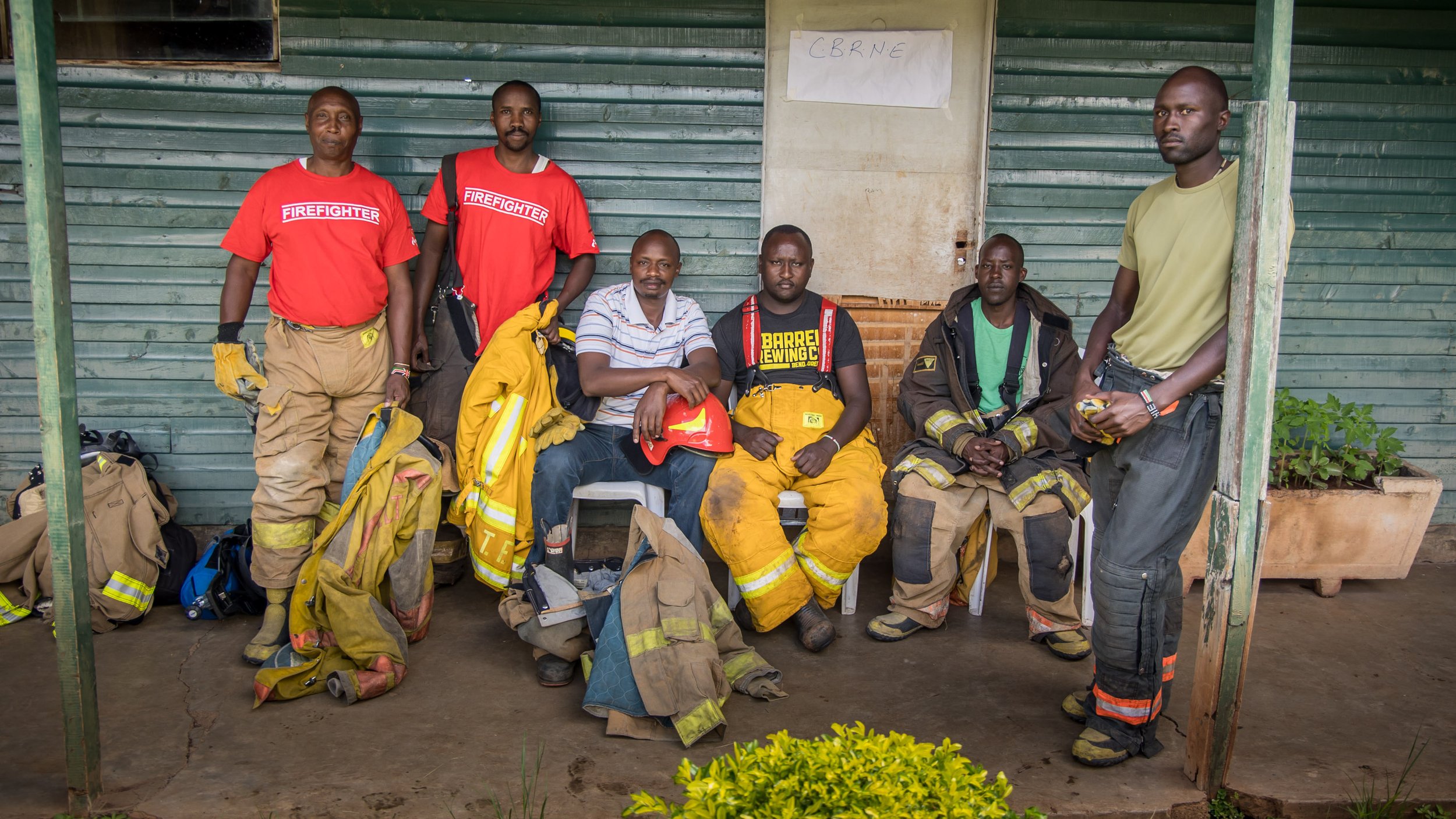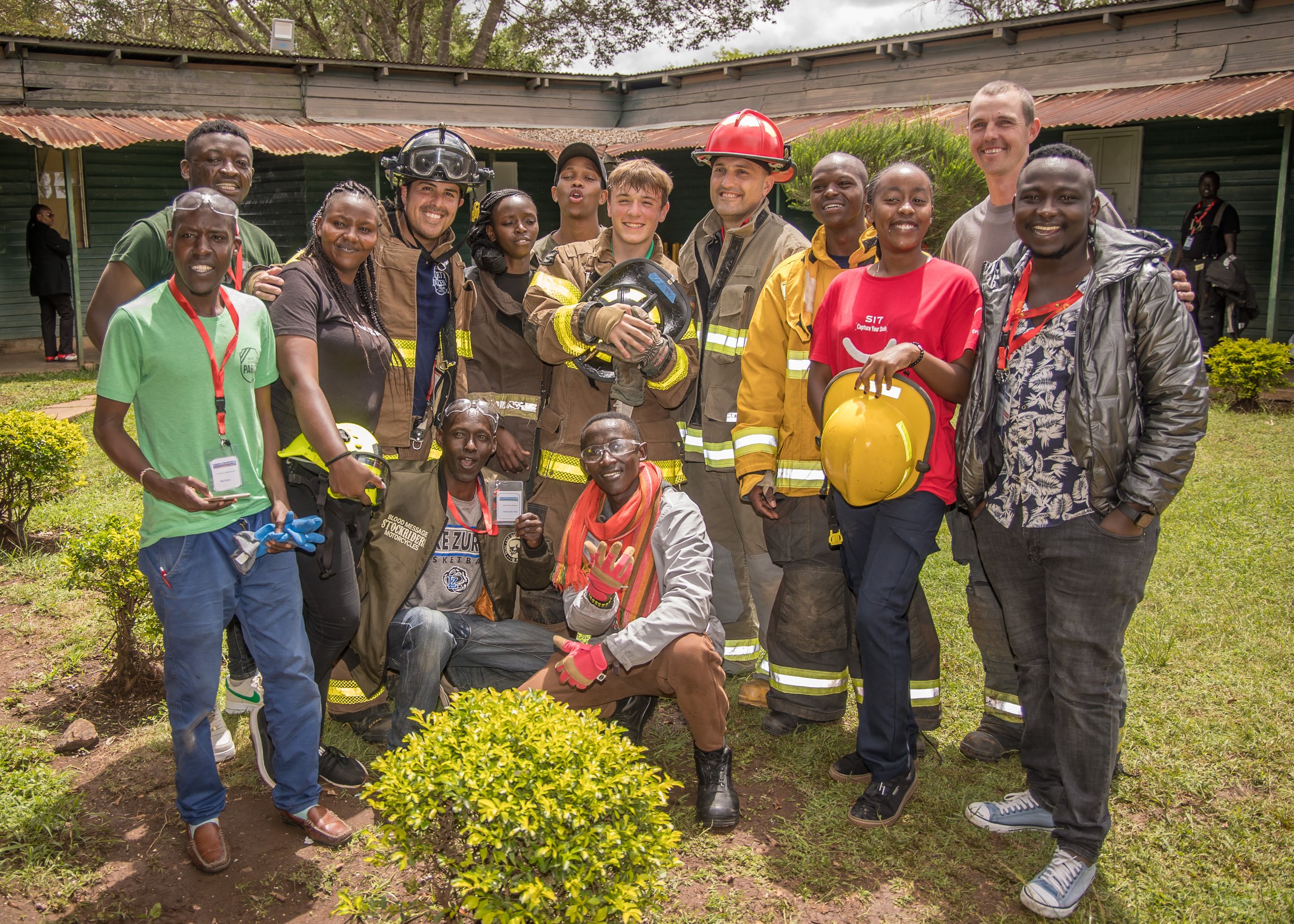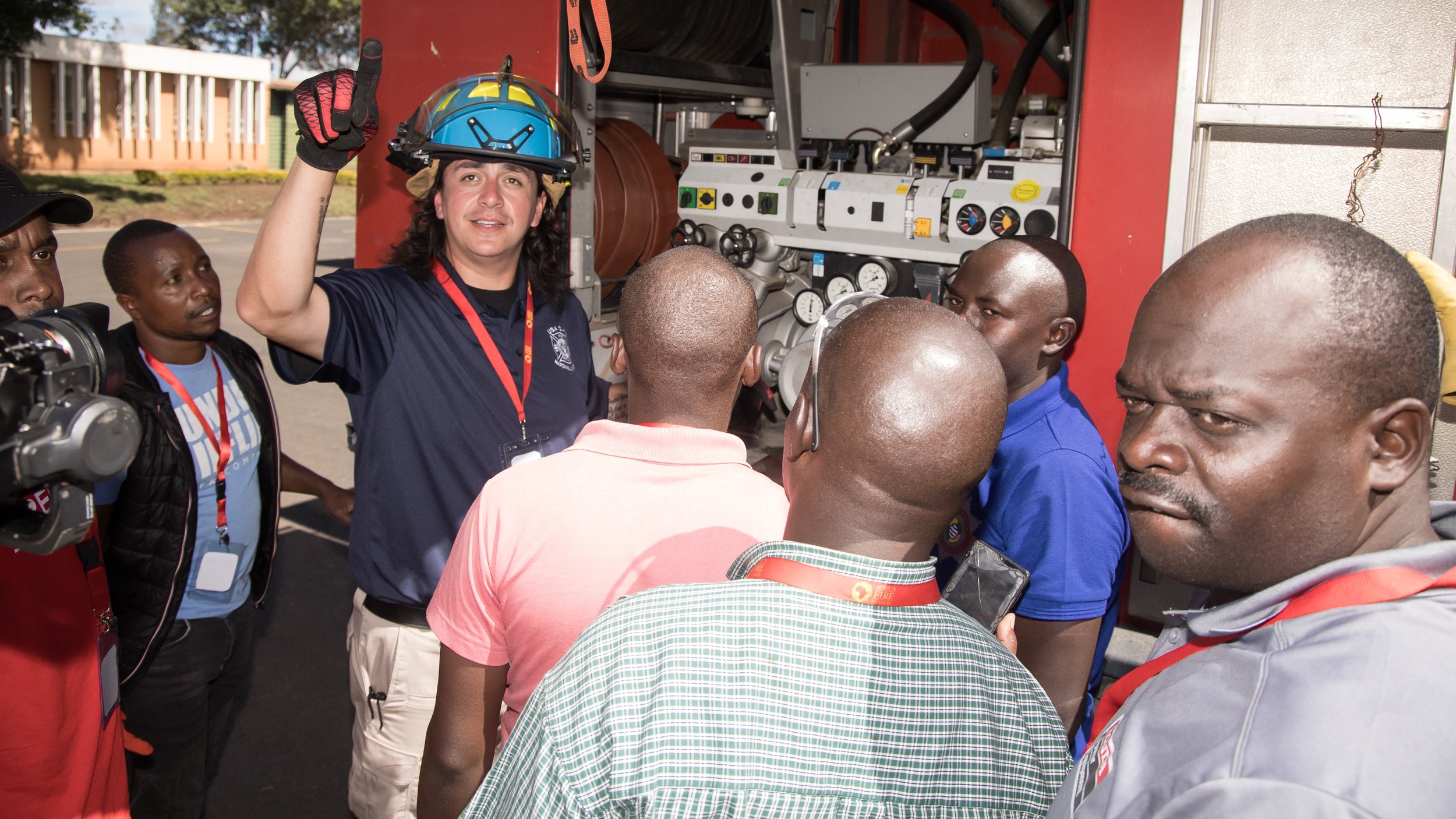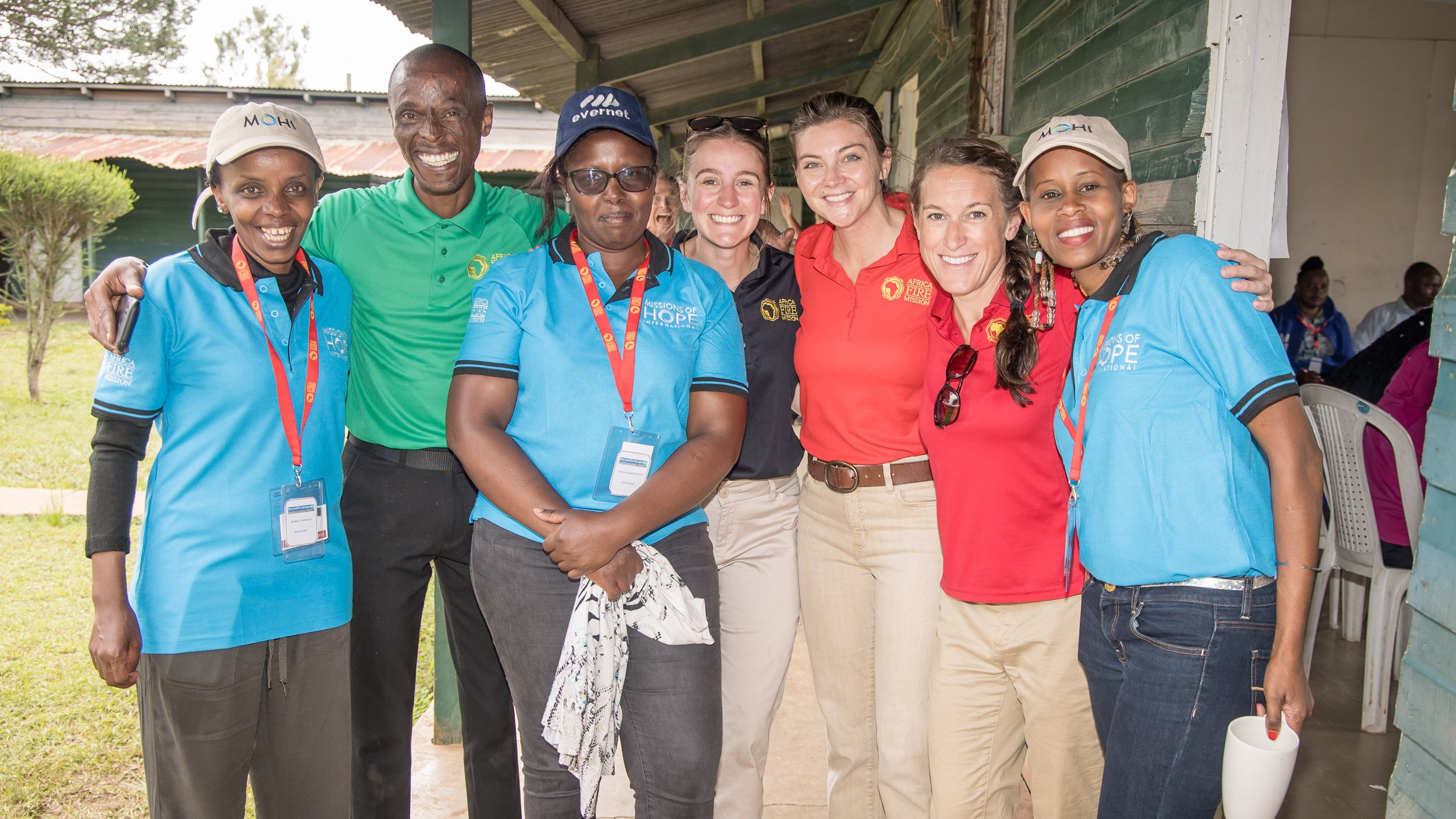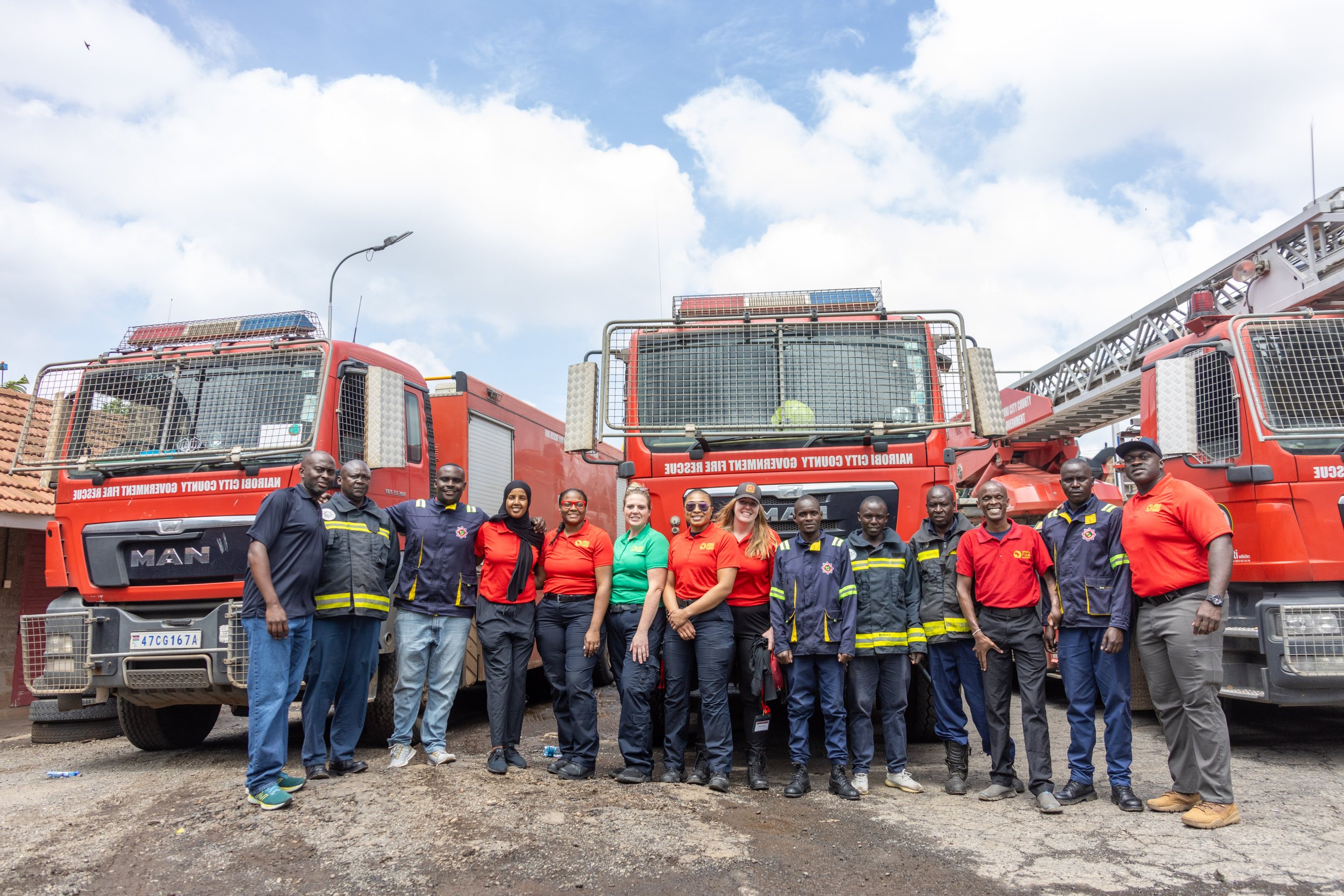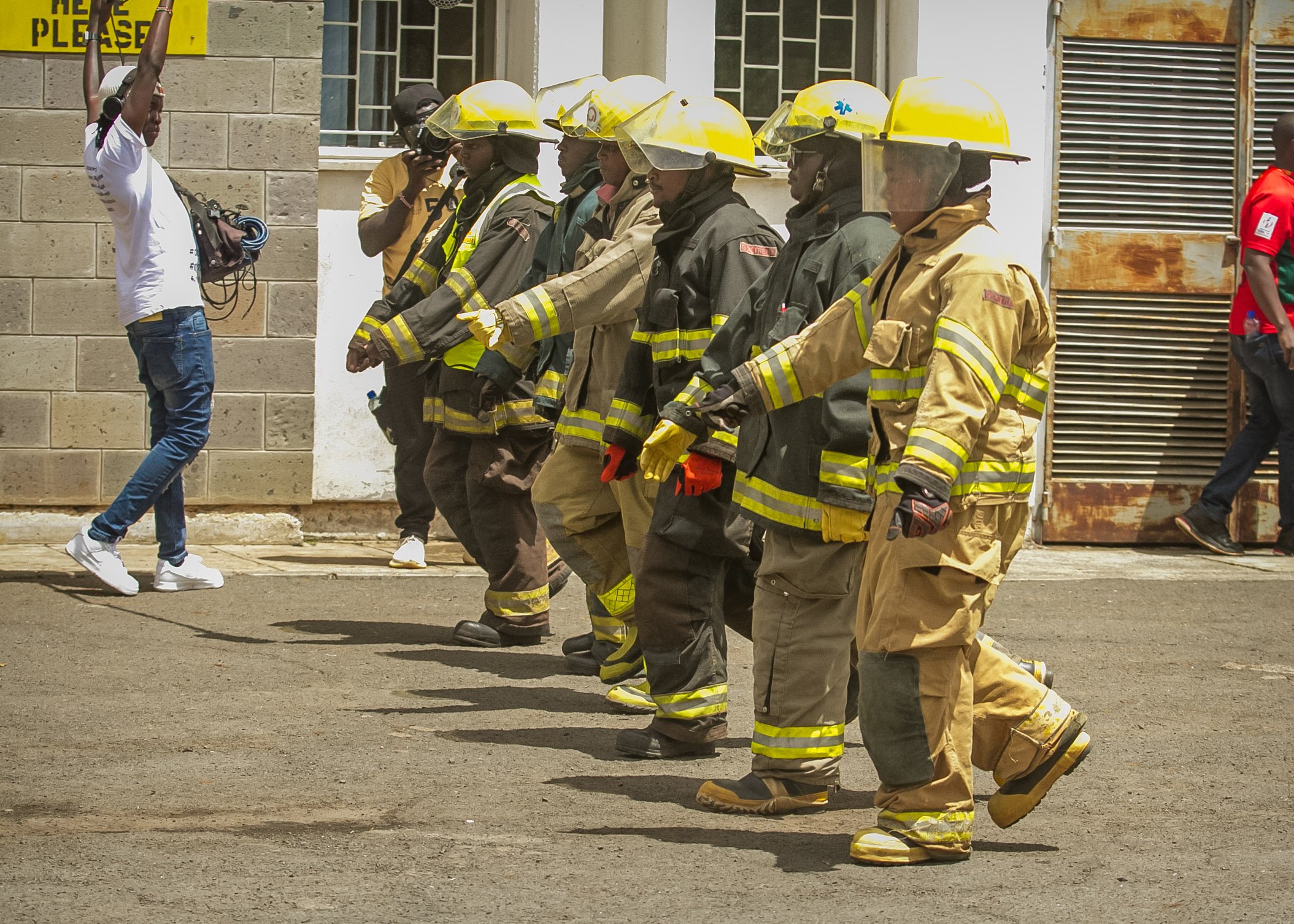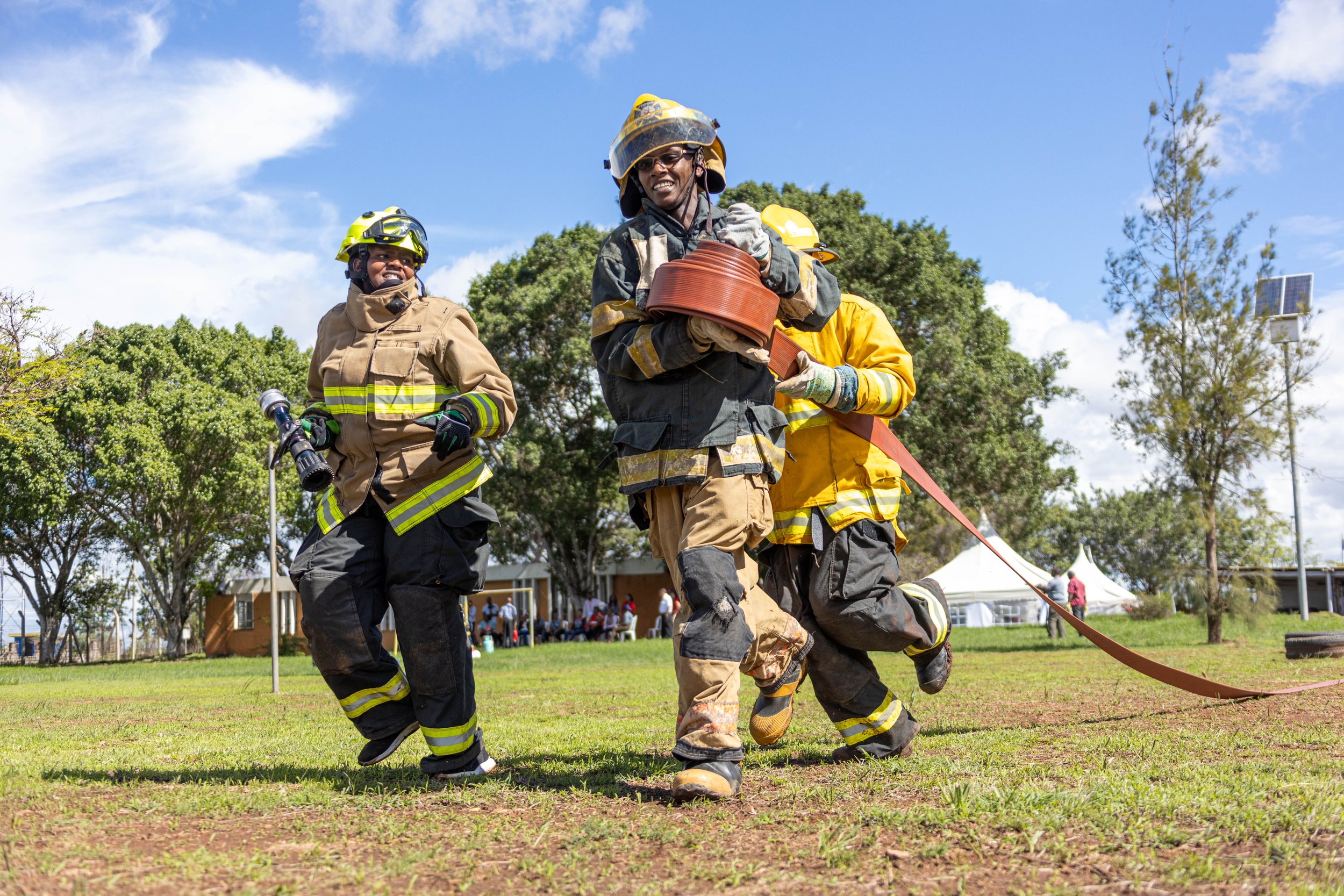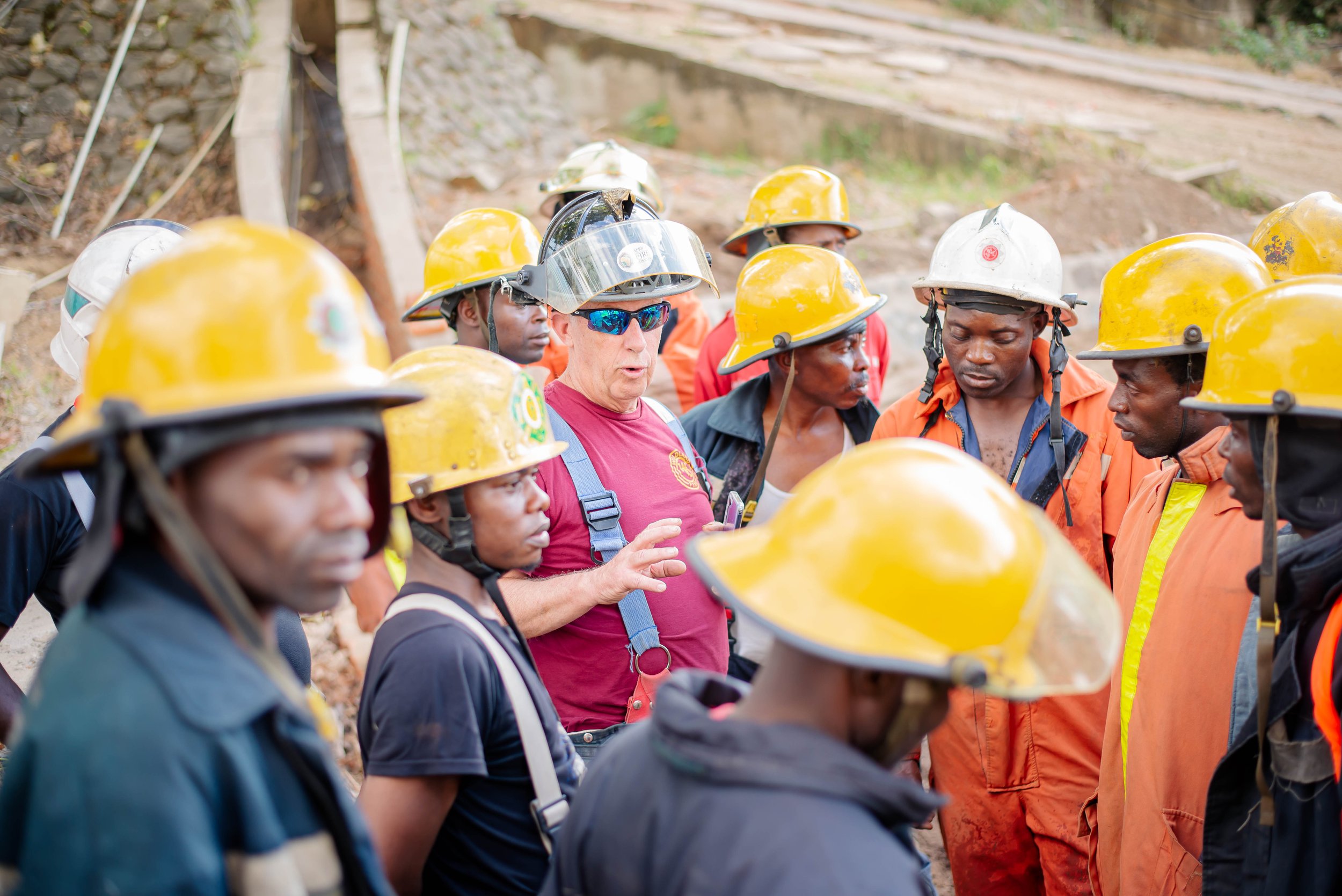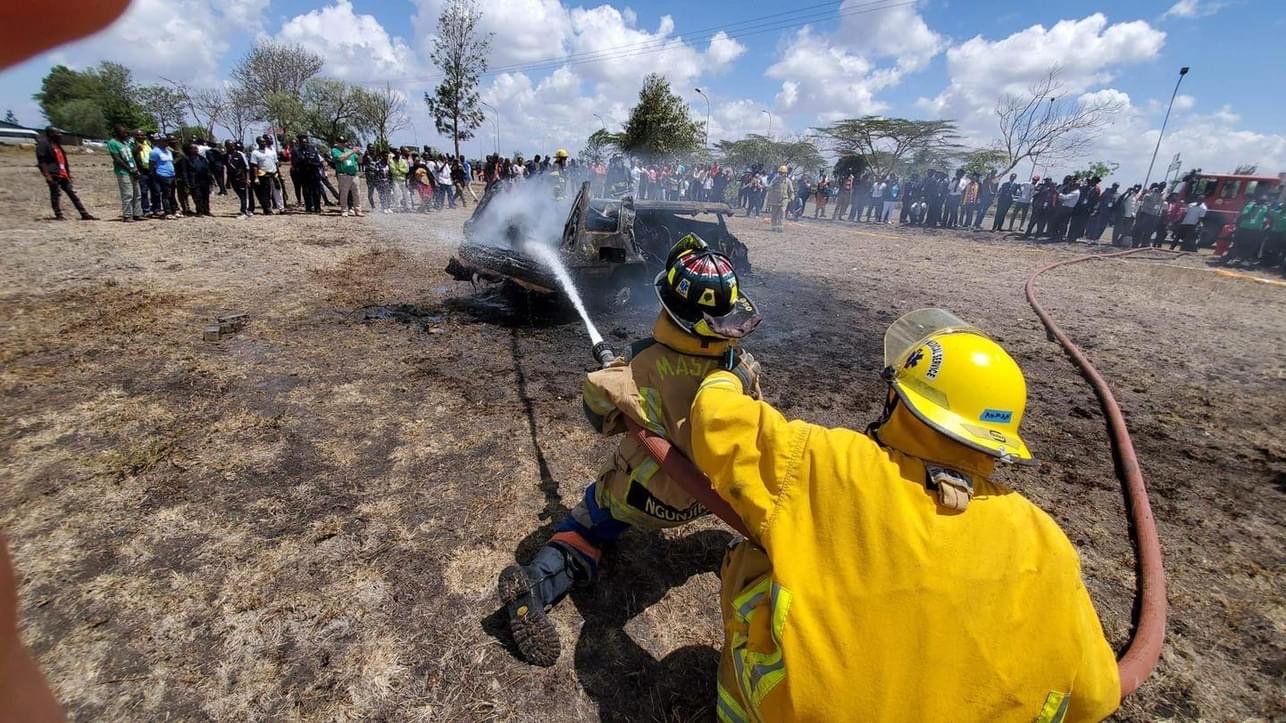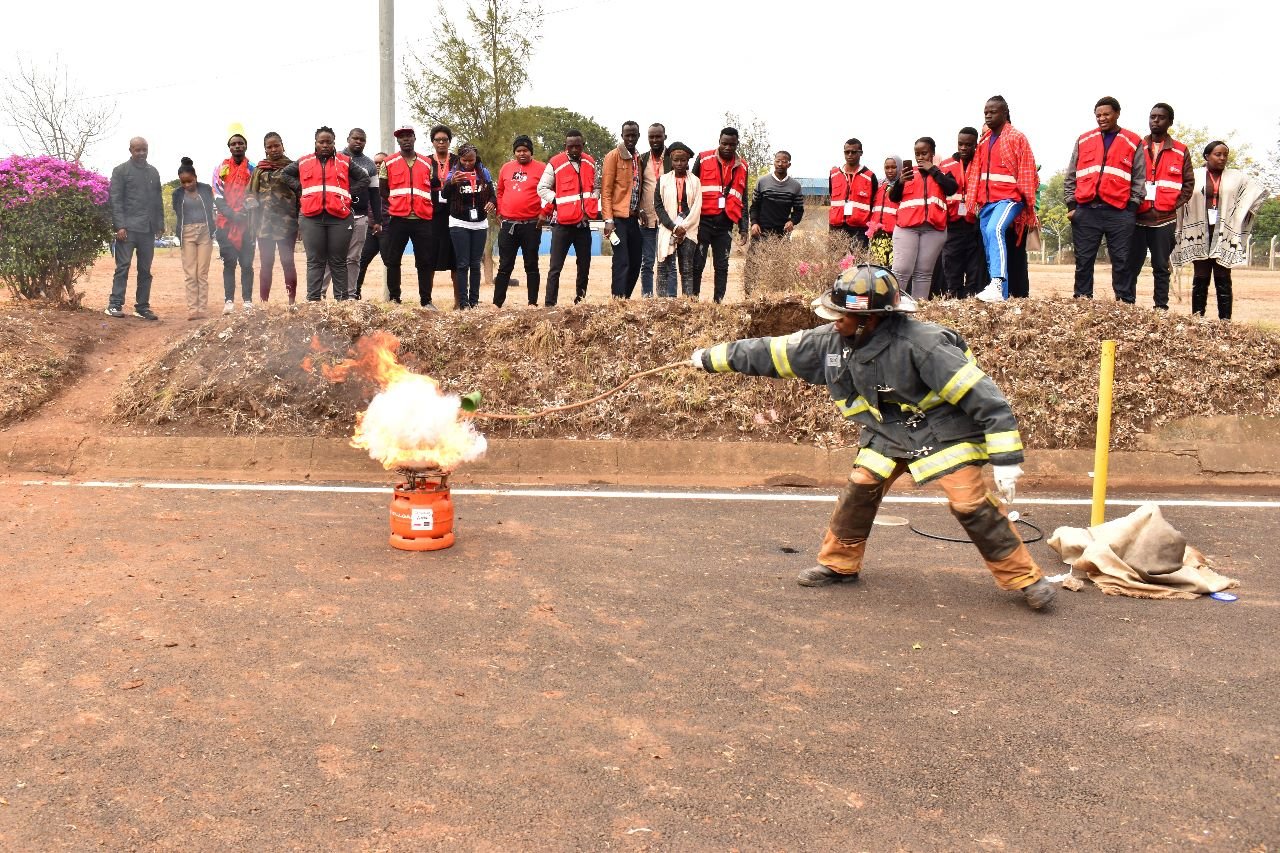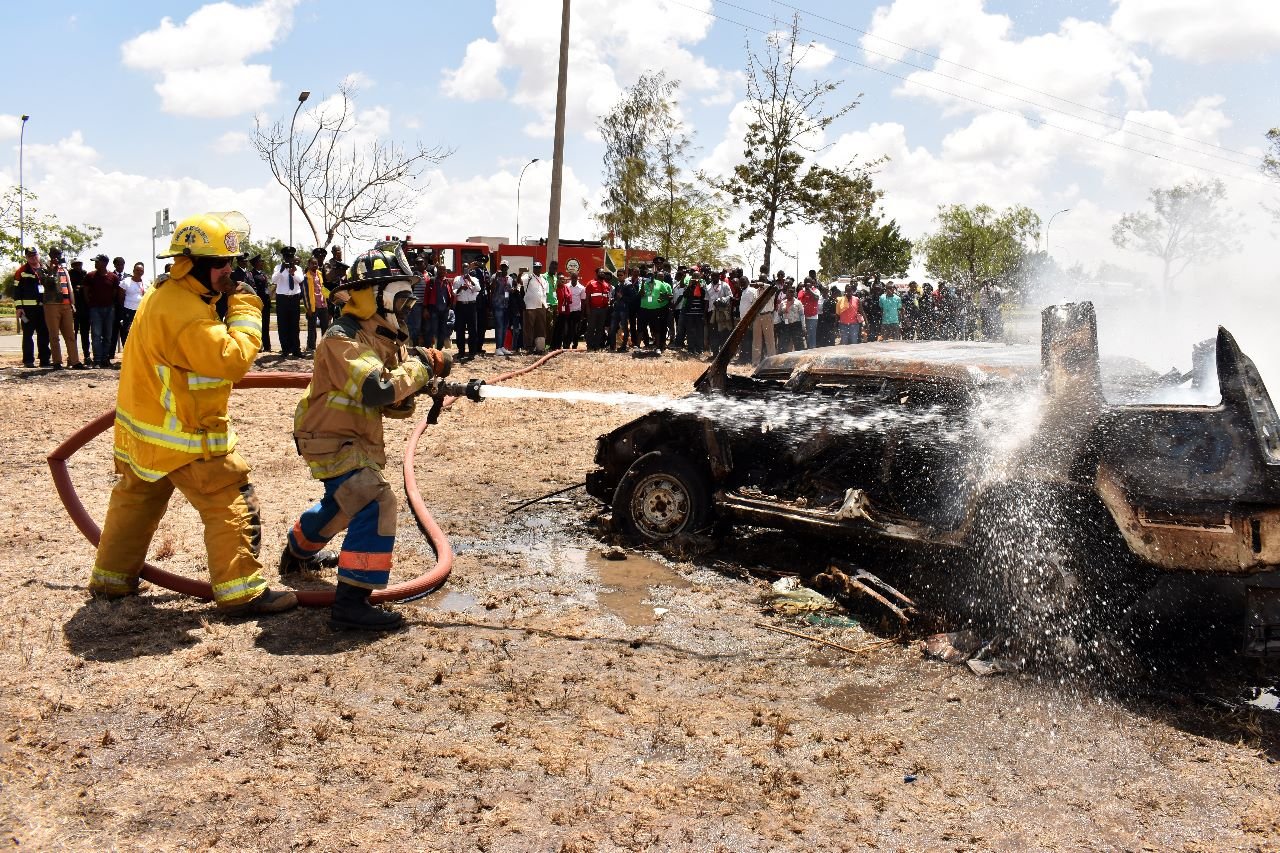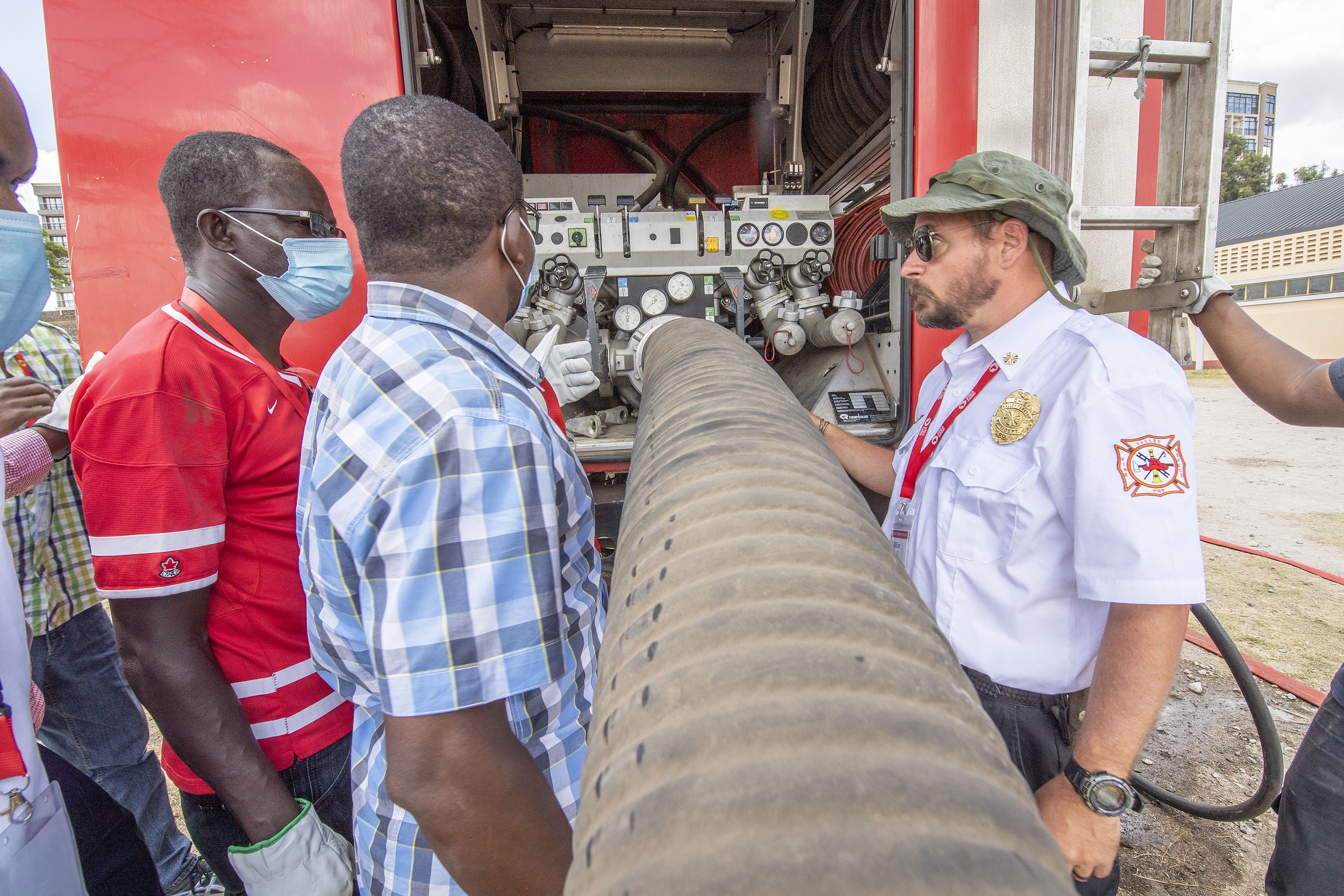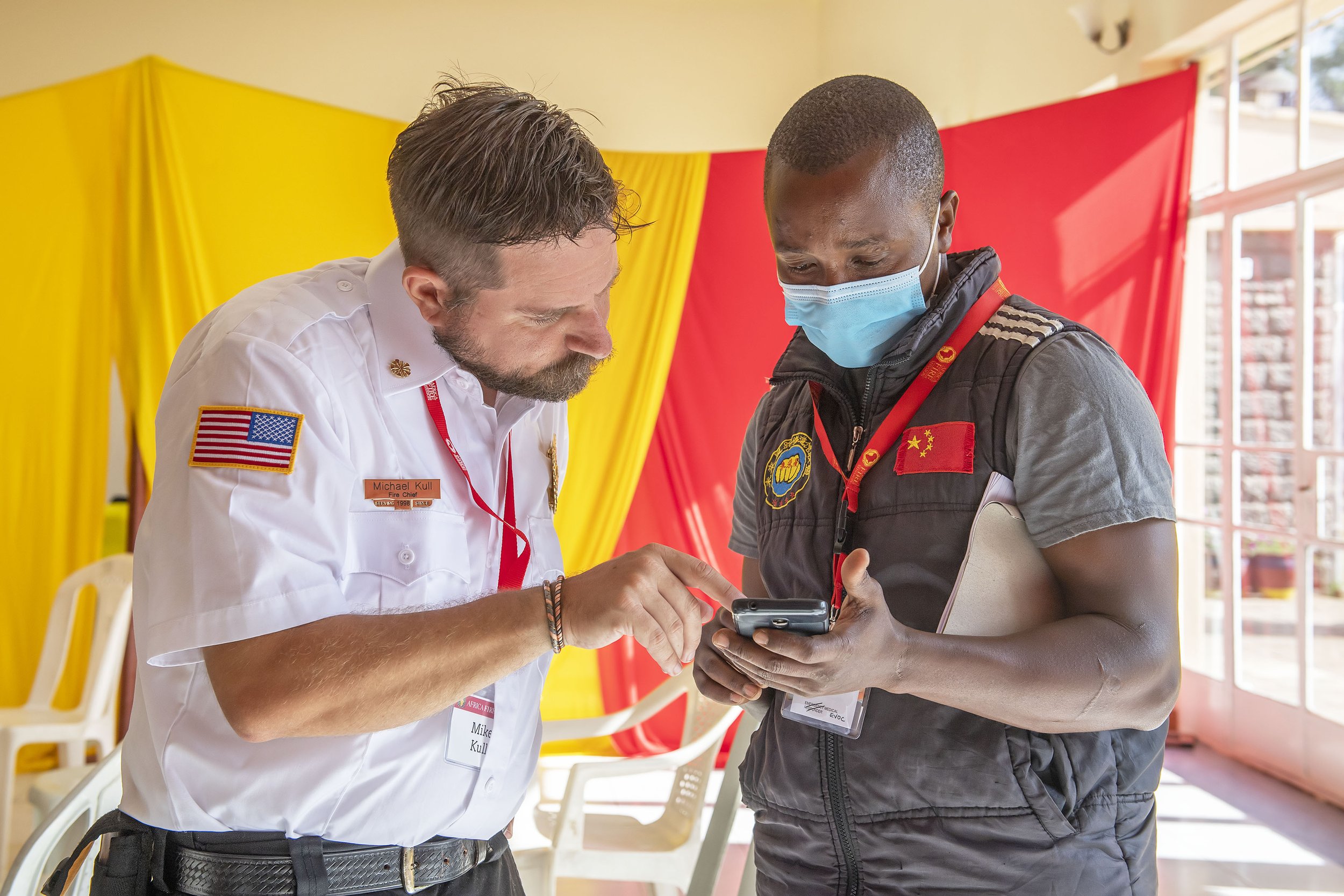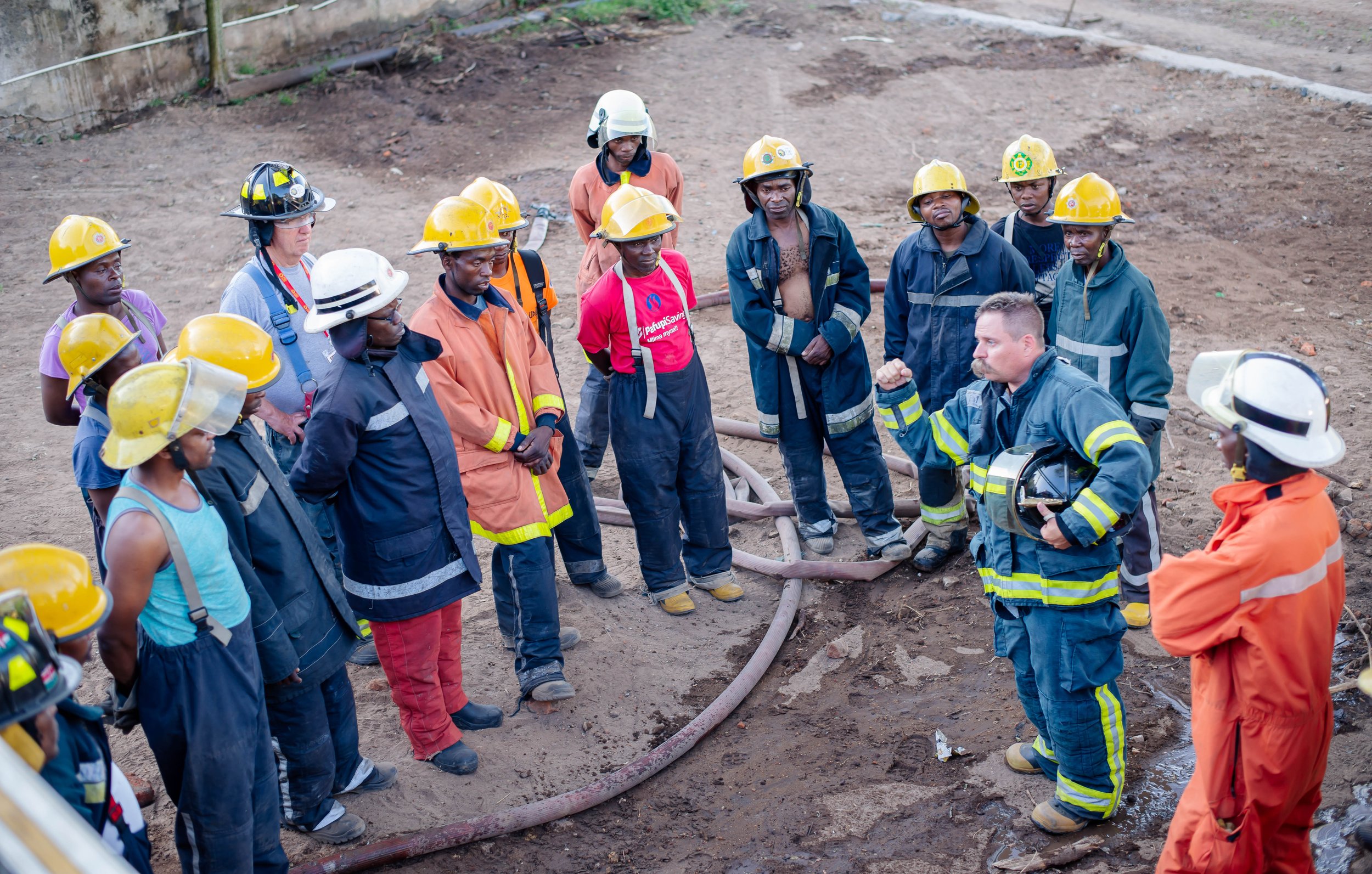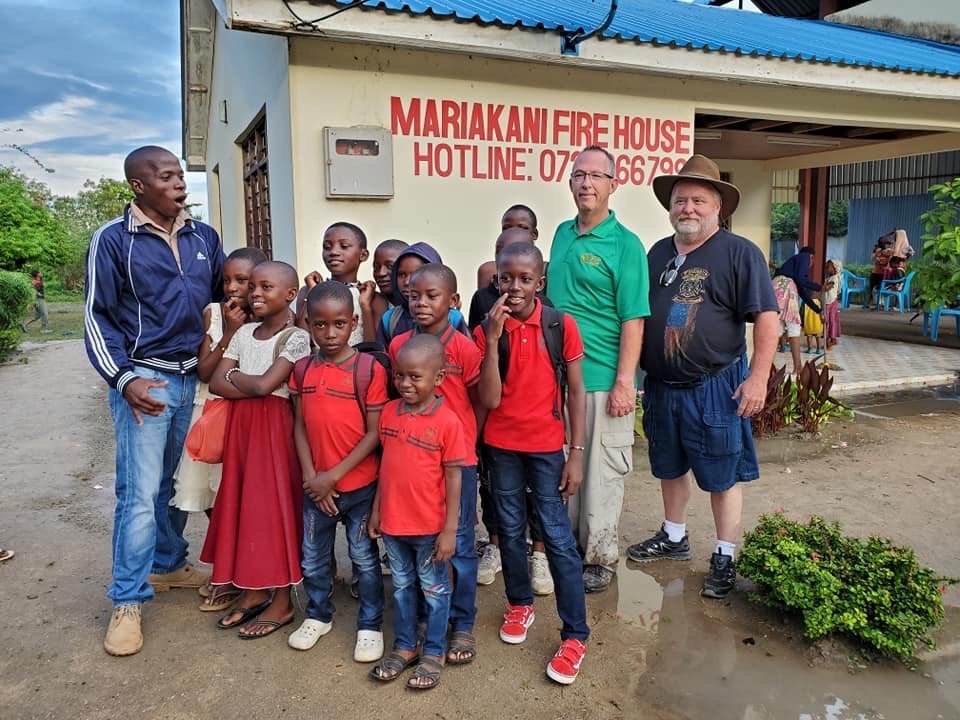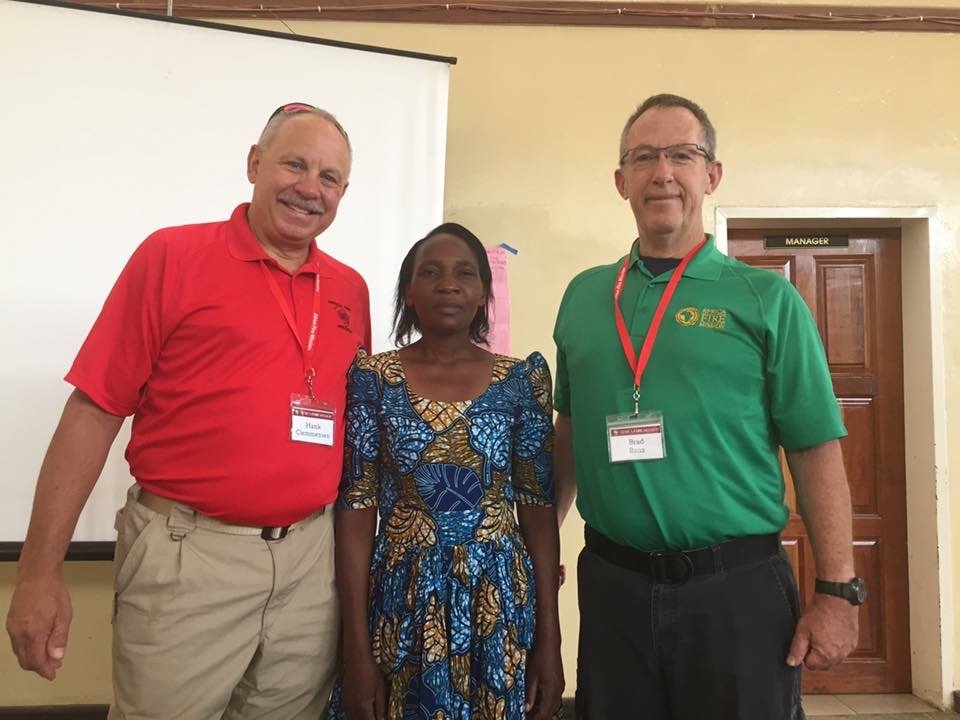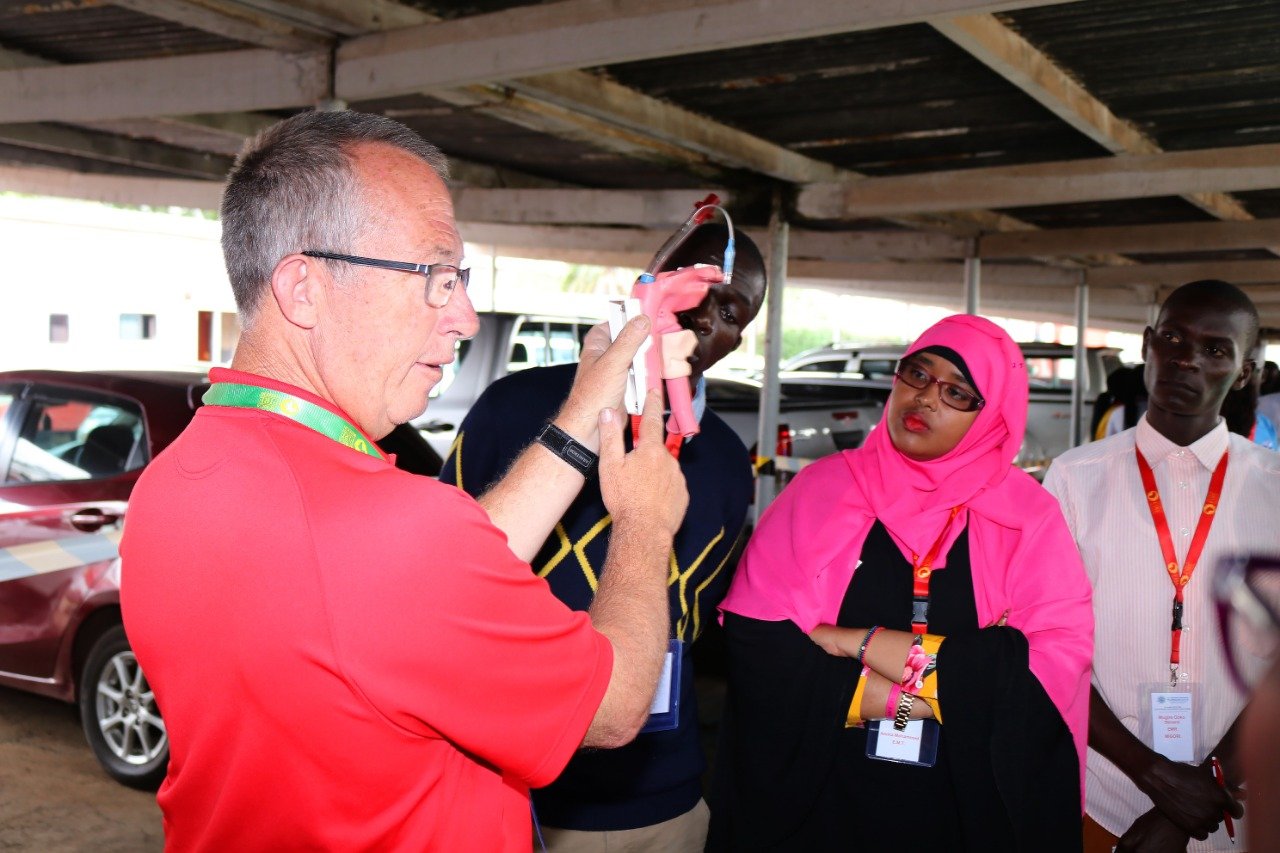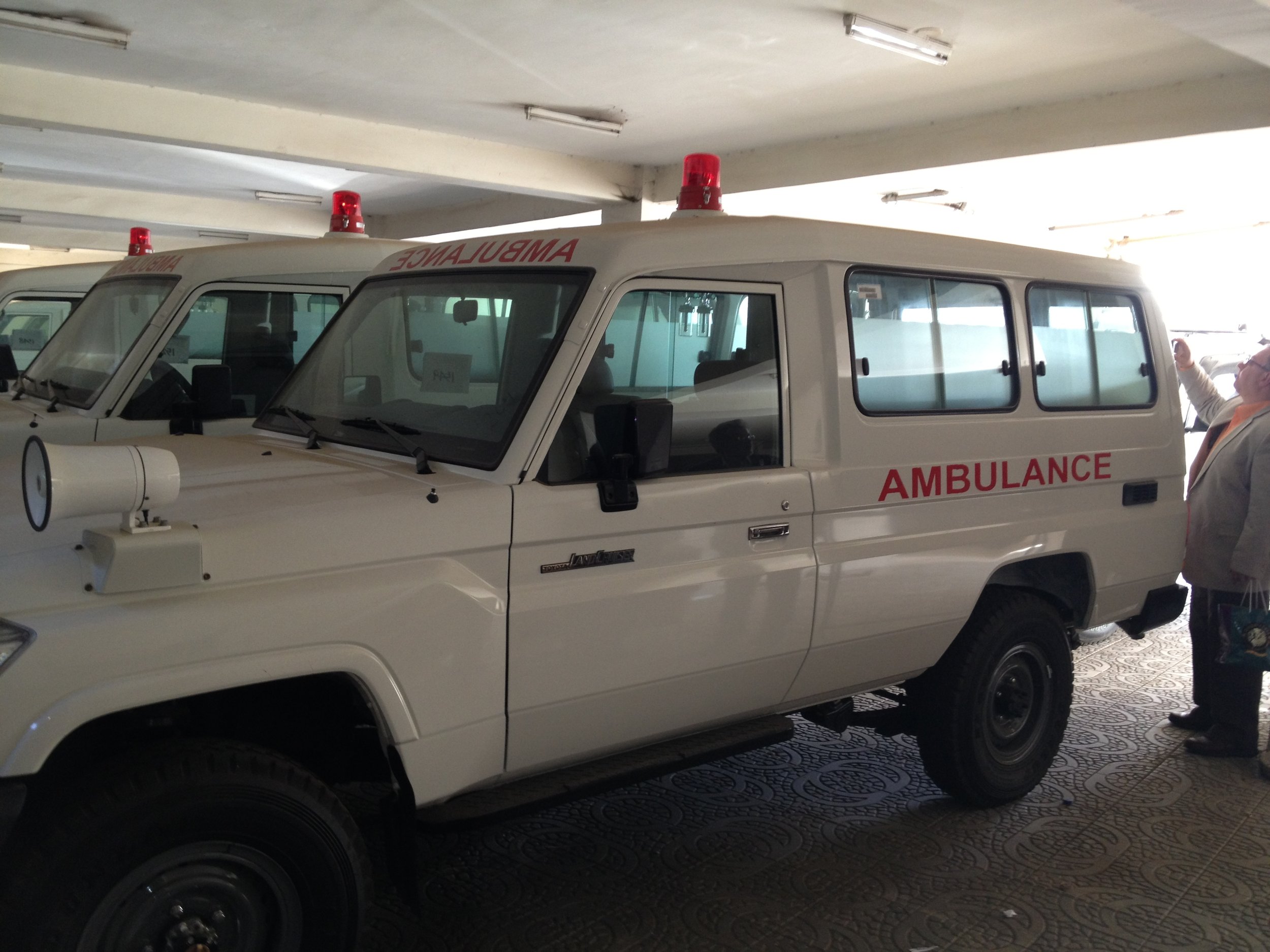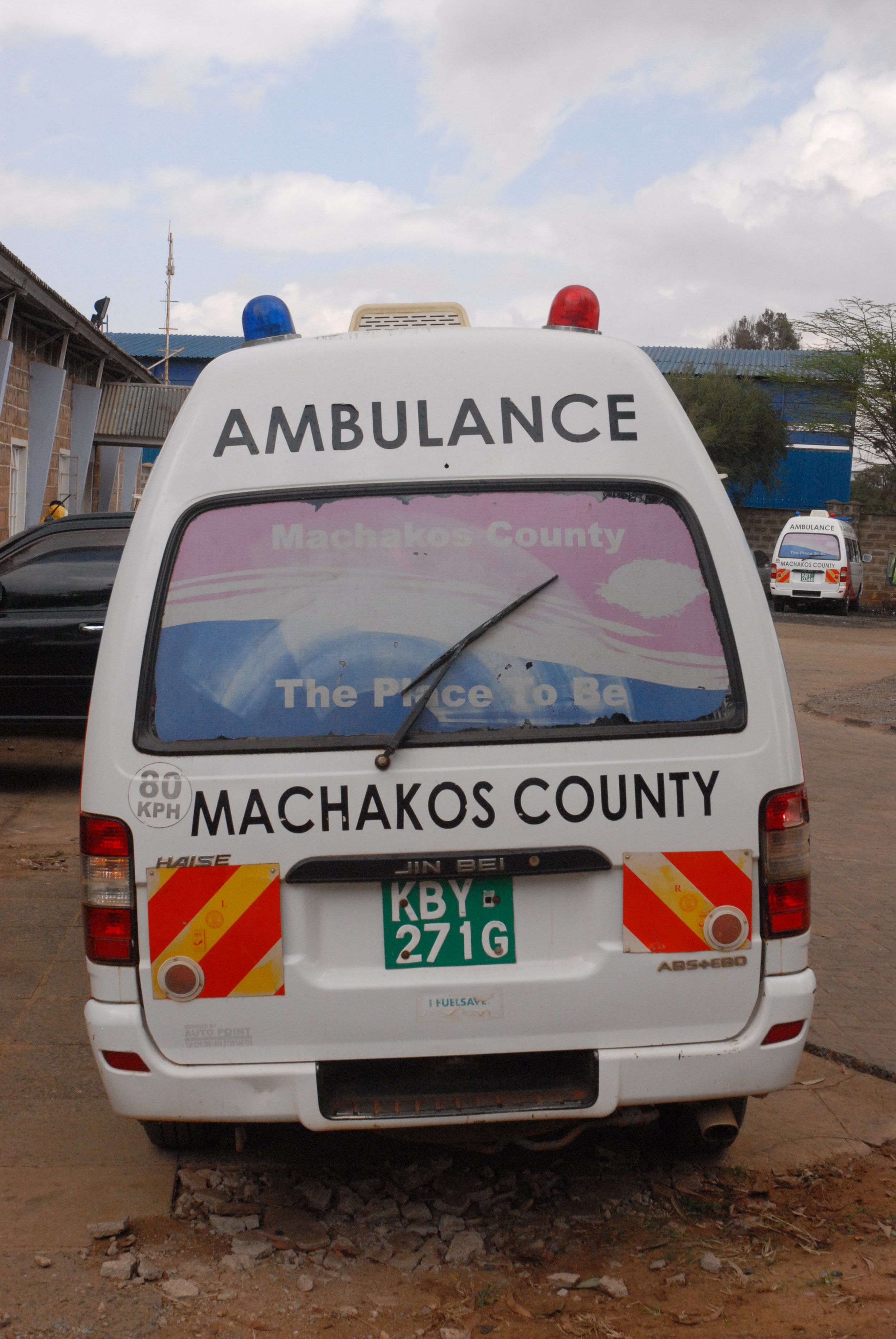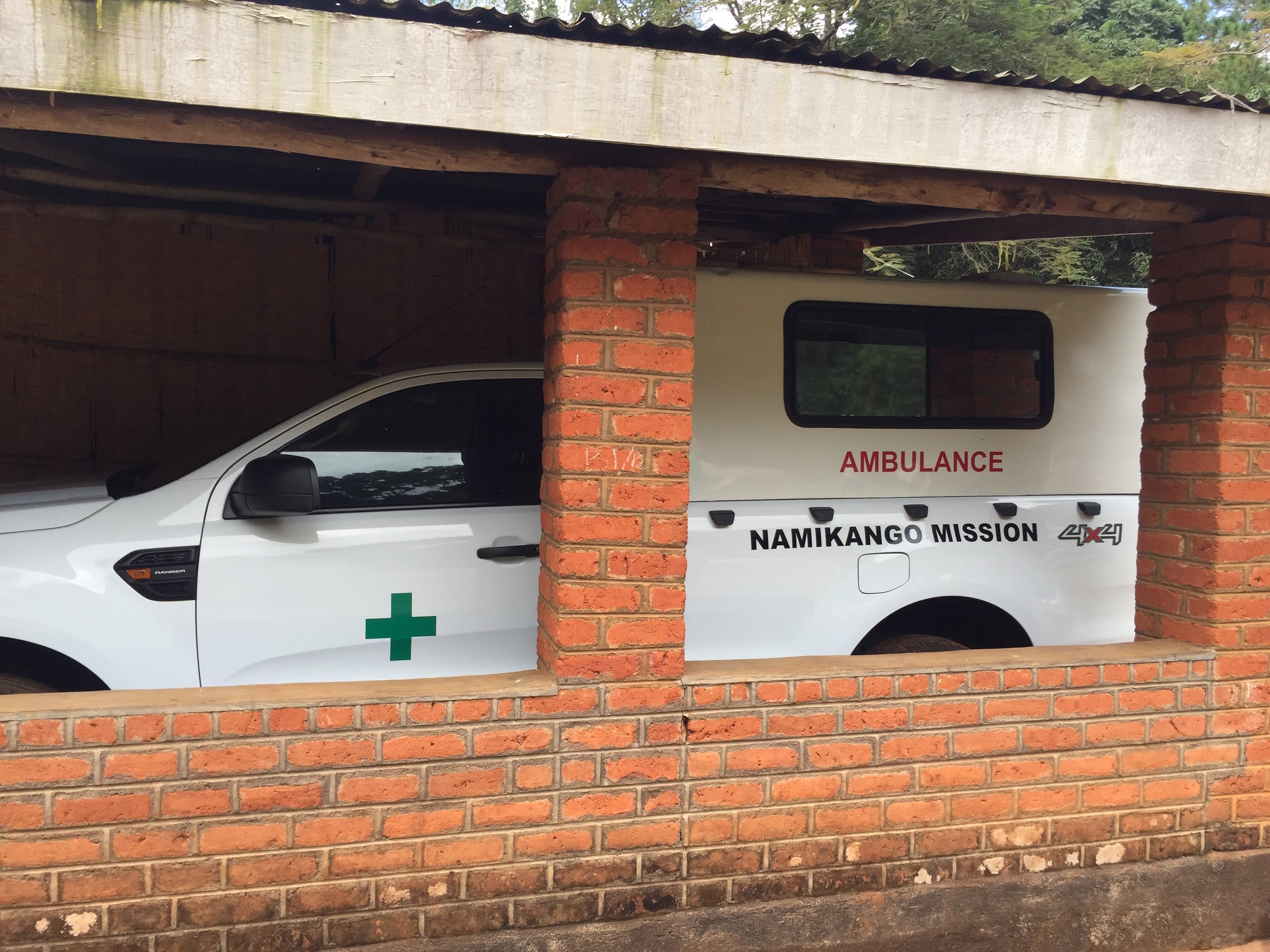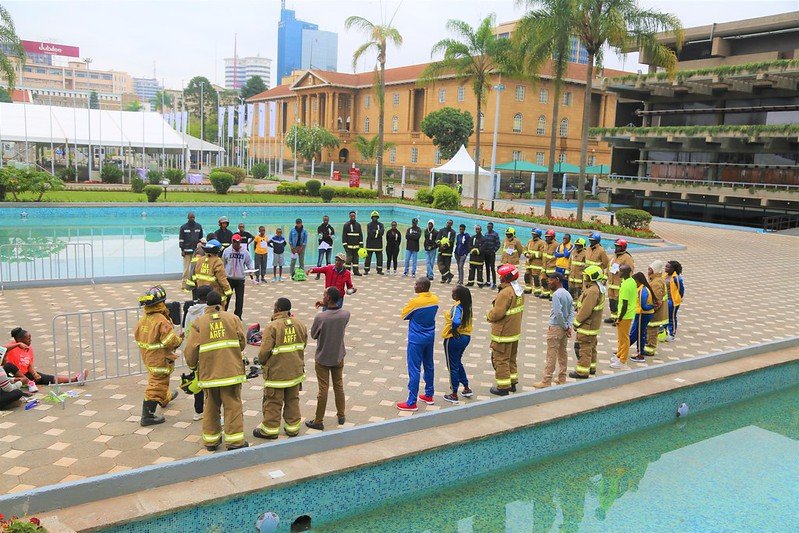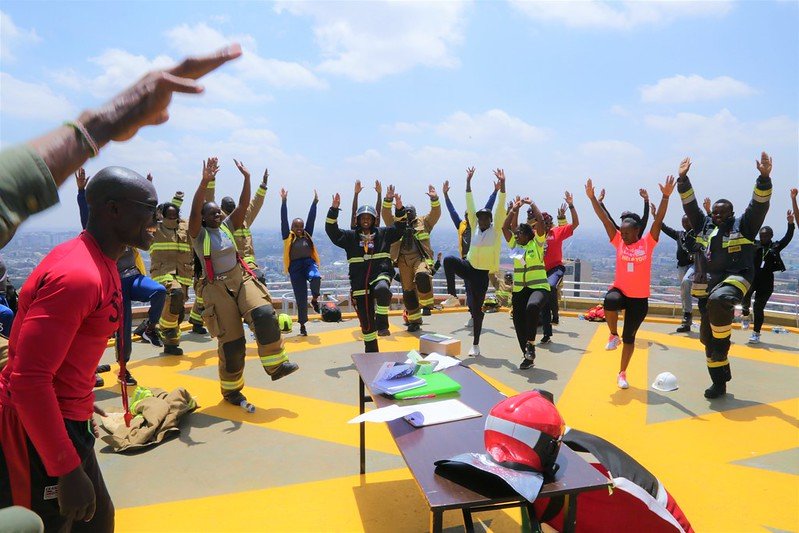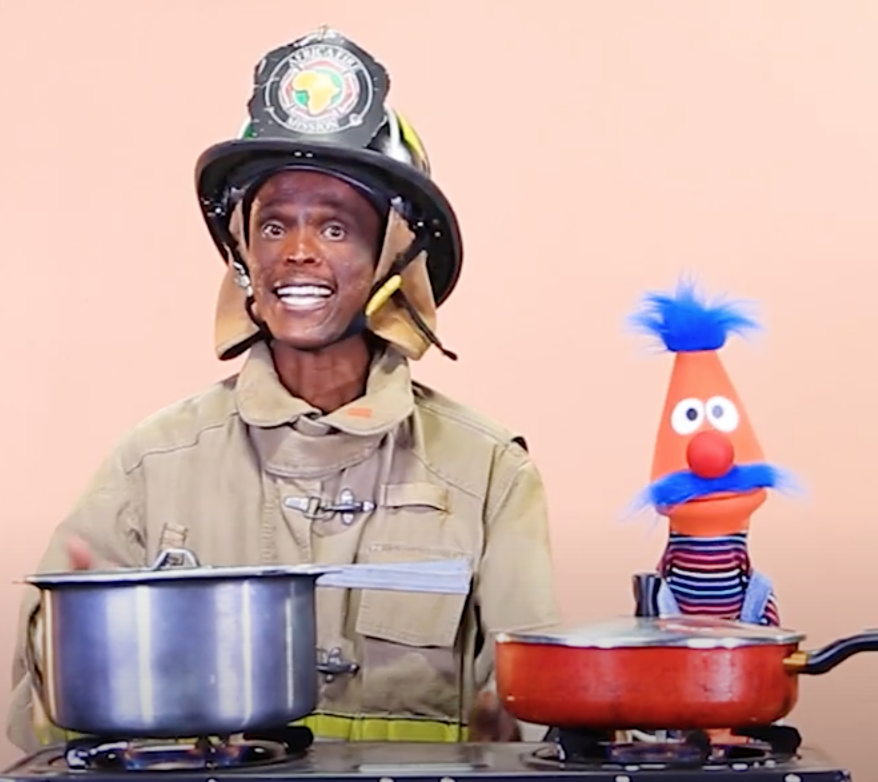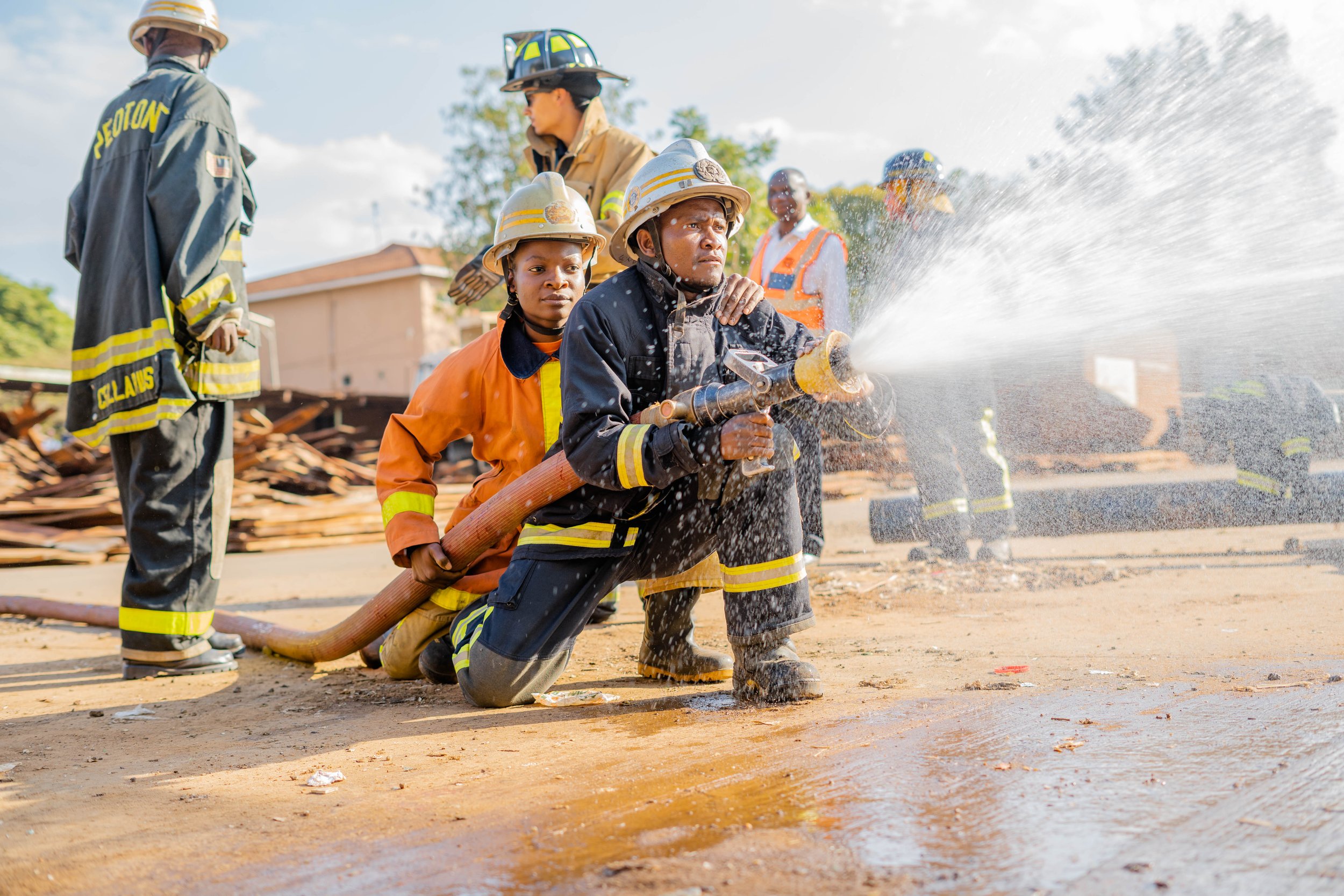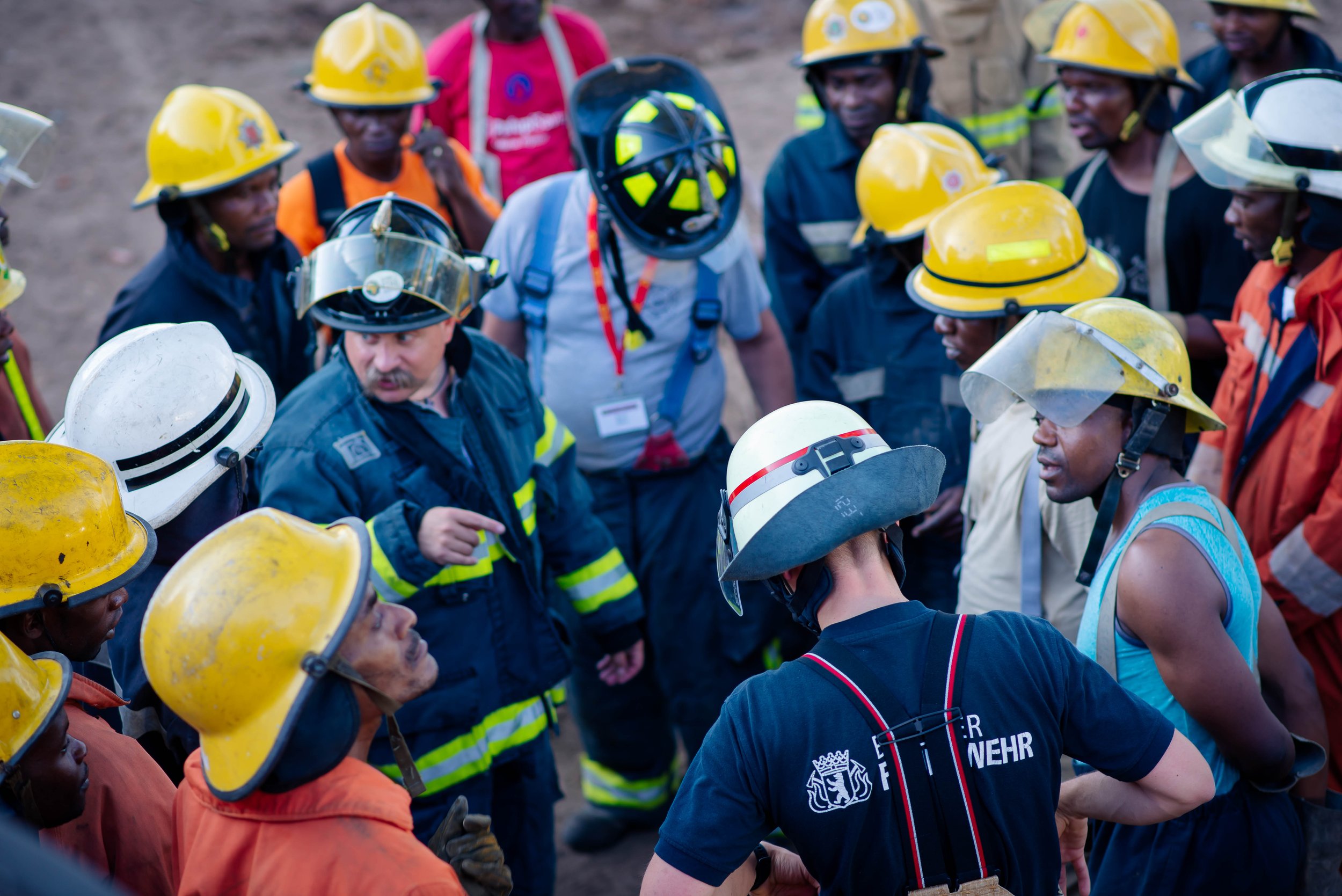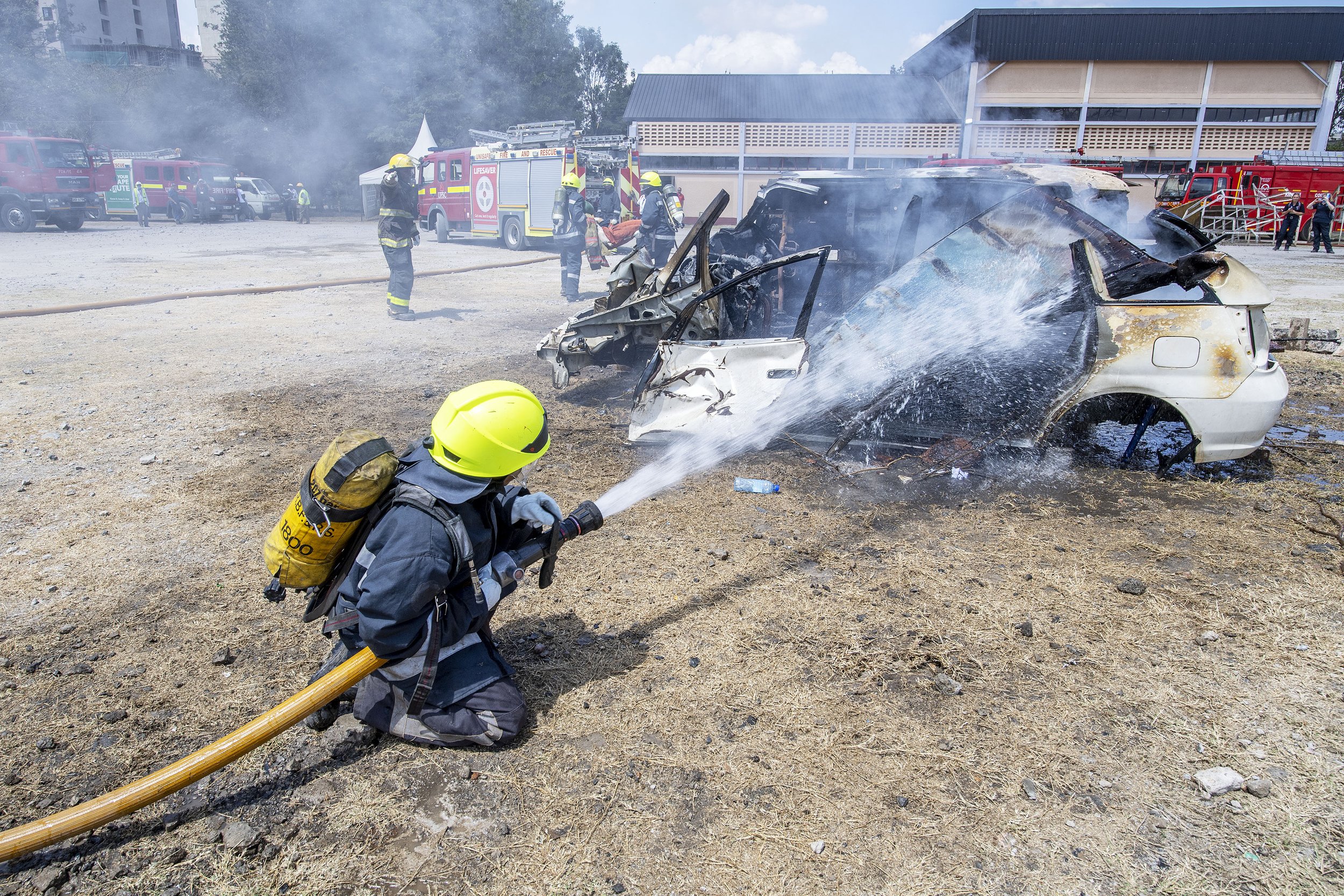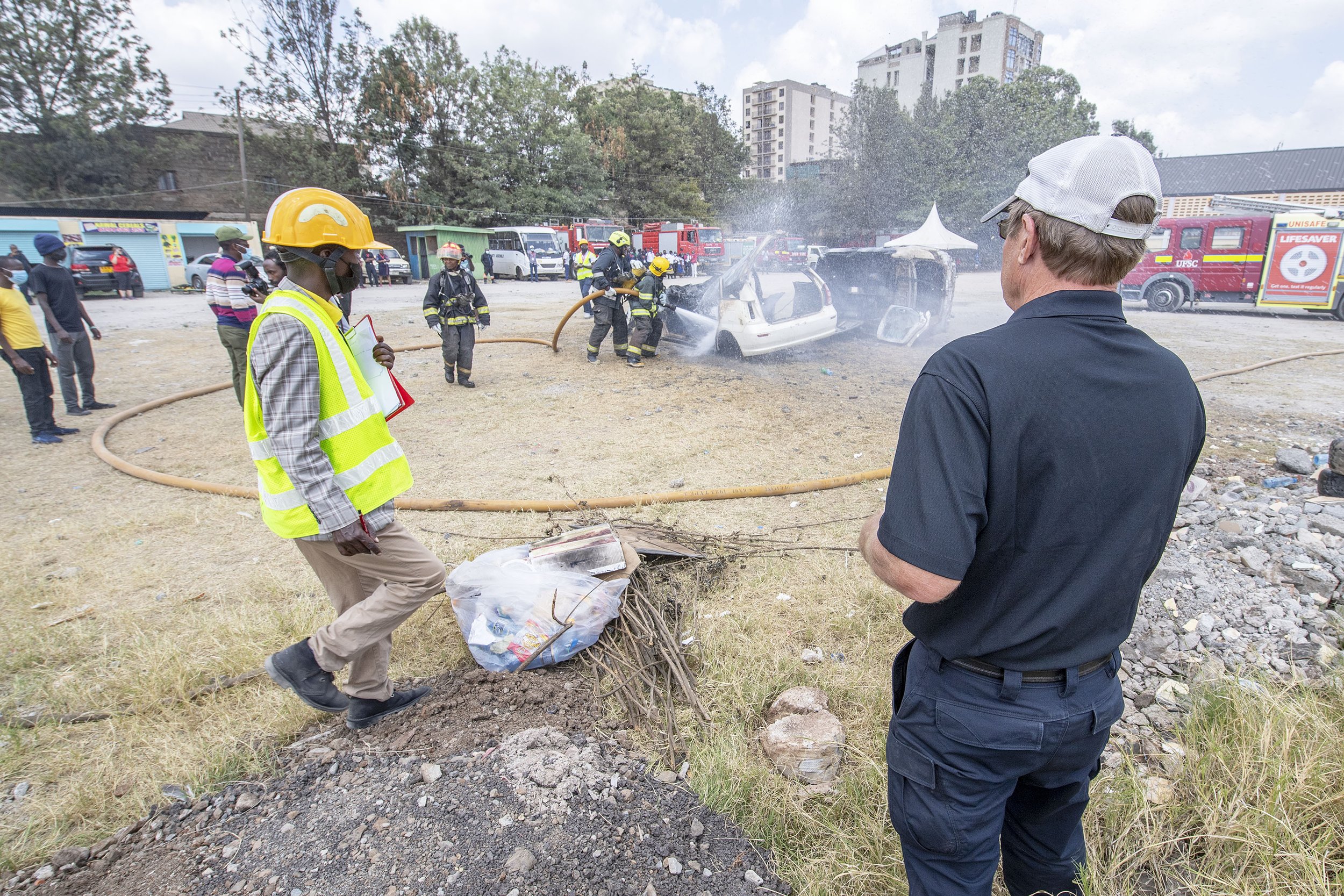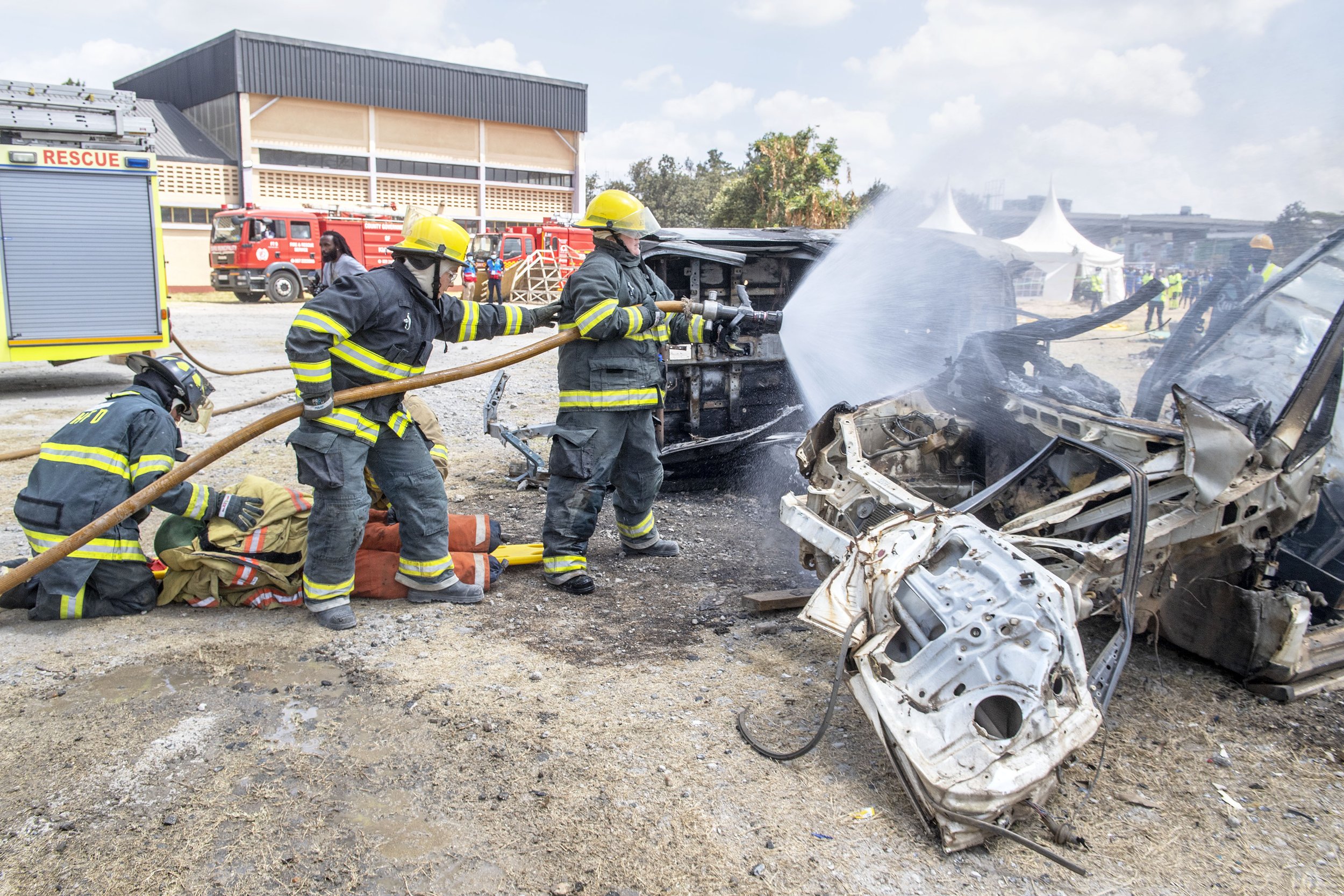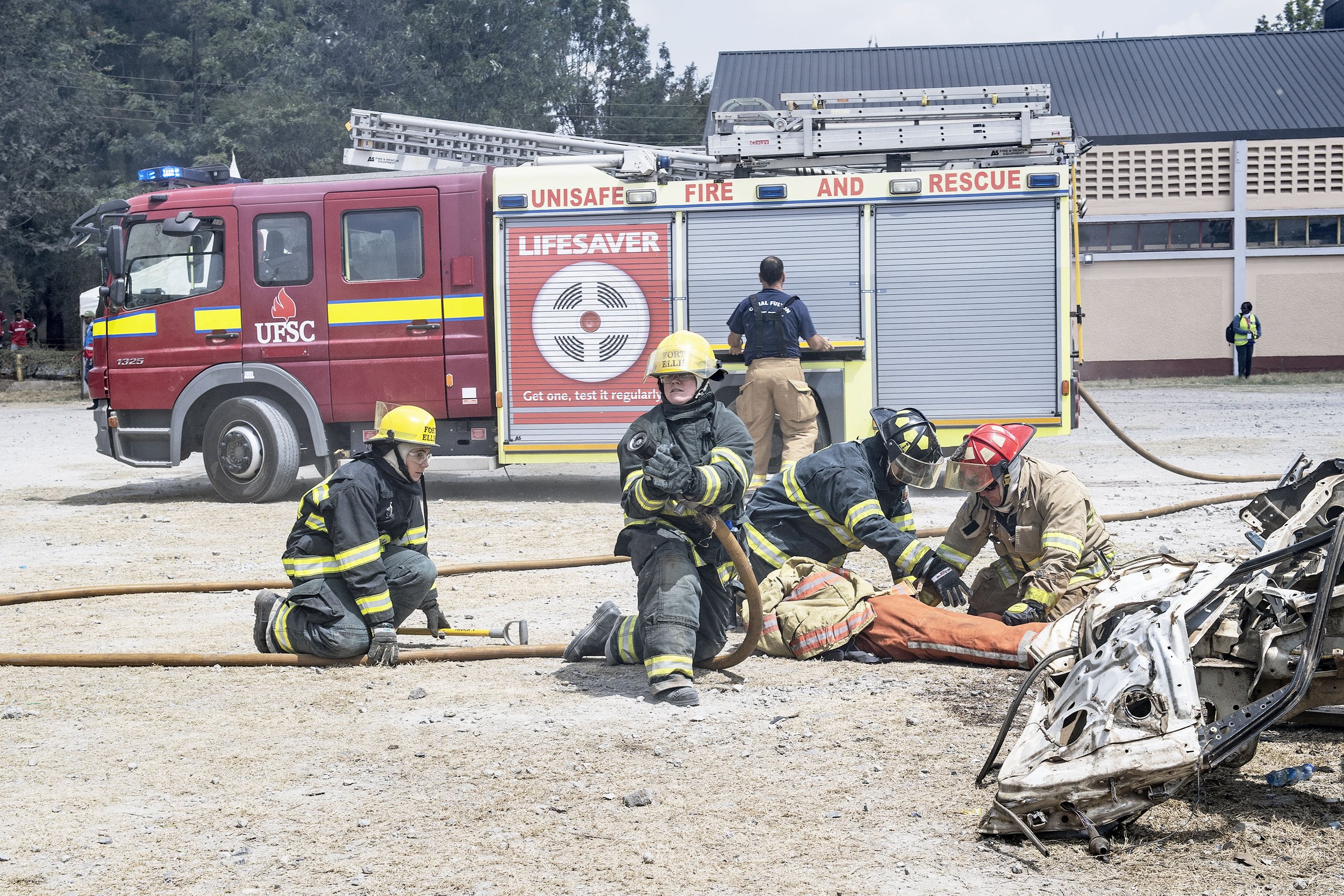From May 7-8, 2024, delegates from over fifty countries gathered in Washington, DC, USA for the inaugural World Fire Congress. This historic event was established by the US Fire Administration with many other partners to connect the fire service around the world and offer an opportunity to strengthen and empower firefighters and their communities. Members of the Africa Fire Mission team were present during the congress and helped to ensure that representatives from Africa were invited as delegates.
Africa Fire Mission at FDIC International 2024
Africa Fire Mission attended FDIC International this year! The Fire Department Instructors Conference is one of the largest firefighting conferences in the world and it gave our team members a great opportunity to network with members of the fire service community. Our team had a busy week connecting with organizations and collecting gear donations. We’re grateful for all the wonderful people we were able to connect with!
SLICE-RS, a Modern Approach to Fire Attack
Acronyms are a common tool used in the fire service as an easy way to remember the proper steps to take in high pressure environment like a structure fire. Today we will look at the SLICE-RS acronym, developed by Assistant Fire Chief Eddie Buchanan, retired, of Hanover Fire-EMS (USA). This system was designed after extensive scientific studies of fire dynamics were conducted in the United States. Many of the things learned from these studies went against the traditional firefighting tactics in the US. The big takeaway from this method is: Everything gets better, for us and any possible victims inside, the quicker we get water on the fire.
The First Five Minutes
The First Five Minutes
by Mark van der Feyst
Every day in North America, fire departments are responding to structure fires that involve residential buildings. The bulk of the workload for the fire department will be the residential home as statistics show that every 86 seconds a fire department is responding to a residential fire. Once a fire department arrives on scene, they need to act quickly as the number one priority on the fire scene is life safety. This involves the occupants inside the residential building as well as the responding personnel. In 2014, there were 2,860 civilian fire deaths attributed to a structure fire.
The time a fire department’s first arriving officer and crew have to affectively size up situation and decide on what action to take in order to address the life safety priority is less than 2 minutes. Within that timeframe, many factors need to be considered, evaluated, processed and then decided upon based upon priorities. The first five minutes are crucial to any fire ground operation and sets the tone for the remainder of the call – it will either set the tone for a successful outcome or it will set the tone for a not so favourable outcome.
Studies have shown that fire grows at a rate that doubles in size every minute. Modern fuel loads and heat release rates add to the fire’s intensity. Every minute that we are indecisive on scene is another minute of rapid-fire growth. By using information gathered during pre-planning and from Dispatch updates, coupled with situational awareness and a strong size-up, the Incident Commander should be able to formulate tactical decisions that have positive influence on truck placement and task assignments taking into consideration manpower issues that face many smaller departments.
The First Five Minutes starts with how to correctly size-up an incident scene, and then how to get the information clearly and concisely to incoming units and Dispatch. As we all know, size up begins when the call comes in and ends when all are back at the station. How can we prepare ourselves ahead of time so that our size up will be streamlined and efficient when arriving? We can do this by sizing up our response districts during our down time or when we are driving around in our response areas. By observing the present clues that are in front of us on a daily basis, we can build a data bank within our minds of what we know exists within our boundaries.
One such area is knowing your response district and the types of residential buildings that comprise it. Knowing the common construction types, the common layouts, the average age of the homes and so on will help with creating different rescue profiles. By having these different profiles, the firefighter and company officer can gauge ahead of time what exactly they are dealing with and when the call comes in, they will have a better understanding of where they are going to and what they are getting into.
Another factor that can be added into the equation of knowing the area is with the demographics. Knowing who in terms of average age, in terms of type of population such as seniors or retirement type of people or maybe students will help with creating a rescue profile. This can be accomplished by searching for this information from local government or from just observing the response district.
Other aspects of the size up is with knowing common locations of where fire victims are found within the residential structure. They are usually found in exit areas such as windows, doors, top of stairs, bottom of stairs, middle of stairs, and in the hallways, at the fire location or in their beds depending upon the time of day. Knowing these common locations helps with the effective rescue and where to begin the search or which tactic to use.
The fire apparatus is another area that can be addressed for the first five minutes. One focal point is with the equipment options available to the membership. This involves setting up the apparatus for quick and easy access of required hand tools for any rescue operation. This involves utilizing compartment space effectively and placing certain tools on the right side of the apparatus.
Along with this is the aspect of combat ready tools. This is where the fire department can have certain tool combinations pre-made or pre-arranged and then placed in a spot on the apparatus that will be sensible and quickly grabbed. Such examples may be the hailgan and the axe, the haligan and the roof hook, the haligan and the maul, or the hailgan and the water can. There are many different tool variations that can be pre-arranged ahead of time.
Having pre-arranged seating assignments is also a good idea to quicken the rescue operation. This is where no matter who sits in what certain seat in the back or the front of the apparatus, they have a specified job function that is standard. This cuts down the time and decision making ability on who will do what – instead allowing firefighters to react based upon their assigned function.
One last area that can be looked at is our tactical options. There are many tactical options that are available for any one fire department to use – it is just a matter of using the right one for the right situation and being efficient with it. Tactics starts with training and becoming familiar with how they are beneficial, the reasons why they are different from each other and how they can be incorporated into the department’s operational capabilities.
Tactical options include things such as VES or VEIS, PPA, tactical ventilation, transitional attack, offensive attack, defensive attack, fast attack, blitz attacks, all hands rescue and so on. Tactics are a great tool for the firefighter and enable them to be effective on the fire ground – but only work when they are trained on time and time again. The place to use a tactic for the first time is not on the fire ground, it is to be used for the first time on the training ground.
By focusing upon these areas and others such as communications, the culture of the department, rescue plans and SOG’s and SOP’s, the fire department can be effective within the first five minutes.
Mark van der Feyst has been in the fire service since 1999 working in both Canada and the USA. Currently he works for the Fort Gratiot Fire Department in Michigan after taking early retirement from his career department at the end of 2020. He is an international instructor teaching in Canada, USA, India and many large and regional conferences such as FDIC, Firehouse World & Expo. He holds an MS in Safety, Security & Emergency Management from Eastern Kentucky University and has been providing virtual training sessions for Africa Fire Mission for two years.
Serving In Nigeria with FCT Fire Service and IHVN
It was great to be back in Abuja, Nigeria in January and early February!
An AFM team of six provided training to FCT firefighters, IHVN staff and partners from the “Committee of Stakeholders on the General Safety & Security of Cadastral Zone C00 Abuja FCT.” The training allowed the AFM team to assess the capabilities of the firefighters as well as gain a better understanding of the community’s perspective of firefighters. Training for the FCT Fire Service focused on enhancing fire response capabilities, promoting utilization of available equipment and tools for firefighting, and enhancing community awareness.
Team member Mike Kull elaborated that “we were able to provide quality training on a wide variety of topics - Breathing Apparatus, Ladders, Hose Drills - Firefighters from FCT Fire Service were eager to learn and we expect to see rapid and positive results from this training. We realize that development is a slow process but we have high hopes for the firefighters here in Nigeria.”
Head of Operations, FCT Fire Service, Engr. Adesina Abioye, stated that the training has updated Fire Service Staff with modern professional ways of rescue and firefighting, and served as a refresher course on fire prevention and administration for the Senior Staff who participated. “The importance of the partnership cannot be overemphasized; it has brought tremendous benefits to the partners and the stakeholders community. What would have cost the FCT administration a huge sum of money was made available at no cost due to partnership,” he said.
AFM also conducted a needs assessment to identify tools and equipment needed to further develop the FCT Fire Service and donated firefighting equipment. This equipment included firefighting coats, boots, gloves, suspenders and helmets for enhanced effectiveness in responding to fire incidents and saving lives, property, and critical infrastructure.
We are grateful that IHVN is committed to collaborating with FCT Fire Service to enhance the capabilities of the fire service and look forward to continued collaboration in Nigeria.
Importance of Active and Passive Recovery for Firefighters
Importance of Active & Passive Recovery for Firefighters
by Nick Higgins
Firefighters are athletes. Taking care of ourselves means not just getting evaluated by our primary care or department physician but truly embracing a healthy lifestyle. Being able understand your body and prepare your body is equally, if not more, important to ensure our personal protective equipment is in check, self-contained breathing apparatus bottles are topped off, and the apparatus is in working order. The rigors and demands of the job place a toll on our physical and mental well-being, and it is vital we prepare our body and mind for the work potentially ahead of us, not just for one shift or call but for an entire career.
Active Recovery
Active recovery is beneficial to the body and may help us recover faster after difficult workouts or strenuous activity. I recommend that this type of recovery be on shift day or the day before or after to allow the body to recuperate from any physical activity performed on off days and to provide your body with some type of active, low-intensity recovery during shift so your body does not go into complete relaxation mode while on call. Limit active recovery exertion to no more than 75% of your typical workout level. The 75% level is just enough to keep the muscles warm and not enough to induce muscle fatigue.
Before we outline a few methods to perform active recovery, here are some of the benefits it provides.
Reduction of lactic acid buildup in muscles.
Elimination of toxins.
Helps keep muscles flexible.
Reduction of soreness.
Increase in blood flow.
Helps keep an exercise routine.
Release of endorphins usually associated with regular exercise.
Here are a few methods of active recovery that are simple, yet highly effective:
Walking
Swimming
Cycling
Stretching
Passive Recovery
Passive recovery is a type of recovery that entails resting for considerable periods of time after strenuous activity. Unlike active recovery, with this type of recovery, your body is allowed total undisturbed rest to repair muscle damage and recuperate.
Proper passive recuperation is necessary for firefighters who are sick, are injured, or need physical and mental relaxation. For firefighters, rest is highly important and needed to perform at an optimal level. Rest has physiological and psychological benefits.
A healthy and optimal life is all about finding the right balance. From a 24-hour shift to 48 hours off in most cases, it is critical to take a day in between every now and then to relax and balance out the body.
By allowing the body to rest and avoid weariness of the muscles, it is allowing the body’s glycogen stores to refill, therefore attributing to the enhancement in muscle recovery. While exercise depletes your body’s energy stores or muscle glycogen, leading to muscular tissue breakdown, adequate rest helps your body correct this problem by restoring muscle glycogen, balancing blood flow, and rebuilding damaged tissue.
Here are a few methods of passive recovery that are simple, yet highly effective:
Sleep
Rest
Hydration
Massage Therapy
How to Use Recovery in Your Regimen
Adding active recovery into your training sessions can be done in two methods, and both are greatly beneficial to your recovery. The first is to add it into your current training session as soon as it has been completed, as a cool-down approach. This is where you will allow your body to ease itself out of your workout, allowing your heart rate and breathing to return to their normal states and reducing the amount of lactate in your blood. The lactate in your blood is an organic acid made by tissue and red blood cells in your muscles, which is what causes the muscle burn felt during exercise. This is the same approach as if you were driving your car and approaching a red light. Instead of slamming on the brakes to make the stop, you gently ease on the brakes for a gradual stop at the light. This same method applies to cooling down after a workout with respect to your heart rate and breathing, by going for a light walk or jog or adding in some dynamic and static stretches and yoga poses. The other option for active recovery is to incorporate this as a full active recovery day and implement the methods listed above as active recovery for the day, through swimming, walking, or yoga to name a few.
Both forms of recovery are crucial within your training cycle regimen to allow your body to find its balance repeatedly as you progress in your training. I highly recommend incorporating cool-down recovery, especially after high-intensity workouts and after fireground training sessions, for optimal recovery of the heart and body with at least one recovery day (active and passive) each week for maximum recovery and performance. In the end, listen to your body and what it is telling you. After all, it is the only place we truly have to live.
Nicholas J. Higgins is a firefighter and district training officer for Piscataway Fire District #2 in Piscataway, New Jersey. He is a New Jersey State Level 2 Fire Instructor, a National Fallen Firefighters Foundation state advocate, and a member of the Board of Directors for the 5-Alarm Task Force—a 501 (c) (3), non-profit organization. Nick is also the founder and a contributor of The Firehouse Tribune website and has spoken at various fire departments and fire conferences nationwide. He is the author of both “The 5-Tool Firefighter,” a book that helps firefighters perform at their highest level and the companion book, “The 5-Tool Firefighter Tactical Workbook” along with being the host of “The 5-Tool Firefighter Podcast”.
The Five C’s of Radio Communications
The Five C’s of Radio Communications
by Mark van der Feyst
The essential elements of effective incident scene communications fall into five categories. Understanding these attributes of successful communication and engaging in the suggested strategies will enhance your communication effectiveness, as well as that of the overall communications on the emergency incident scene. These are known as the Five C’s of Radio Communications: Conciseness, Clarity, Confidence, Control and Capability.
Conciseness
· Keep the messages short and concise. This will help in reducing radio traffic.
· Keep the messages specific. Think about what you want to say before you speak and then say it.
· Condense the message as much as you can while still keeping it complete. This will help in eliminating any confusion by the receiver.
Clarity
· Use standard terms as defined in your department’s procedures. This will avoid any confusion on the incident scene.
· Use plain-text language in all radio communications. Avoid using ten-codes, acronyms, or technical jargon.
· Avoid multitasking. Describe and assign one task at a time to company members. Do not overload a company with multiple tasks to be completed at one time.
Confidence
· Communicate on the radio in a calm manner. This helps to maintain calmness on the incident scene and does not create or add to hysteria.
· Be audibly received. Speak in a voice loud enough to be heard by the receiver. Do not speak in soft tones or yell into the radio. Yelling will distort the message, whereas speaking too softly will require repeating of messages.
· Use a good vocal pitch to communicate. This will help to be audibly received. Having a high pitch or a low pitch will have the same impacts as in the previous point.
Control
· Take control of the radio communications on the incident scene. Follow established departmental procedures and protocols.
· Minimize unnecessary radio chatter. Prioritize messages to be sent and received.
· Keep your emotions in check. This will help with establishing confidence and allow for more sensible direction to be given.
Capability
· Use active listening skills. Be sure to hear all the messages that are being transmitted to you. This may require being in a quiet place versus being outside near a working engine.
· Know how to use the communications equipment. Know where to hold the radio or microphone in relation to your mouth, SCBA face piece, or other radios nearby that may produce feedback.
about the author: Mark van der Feyst has been in the fire service since 1999 working in both Canada and the USA. Currently he works for the Fort Gratiot Fire Department in Michigan after taking early retirement from his career department at the end of 2020. He is an international instructor teaching in Canada, USA, India and many large and regional conferences such as FDIC, Firehouse World & Expo. He holds an MS in Safety, Security & Emergency Management from Eastern Kentucky University and has been providing virtual training sessions for Africa Fire Mission for two years.
Successes of 2023 and Opportunities for growth in 2024
December 2023 -
WOW! It’s been a busy year for Africa Fire Mission and every week we get requests to serve in new places!
Here are some highlights of the work you’ve supported this year -
· Team mission trips to Kenya & Malawi with more than 40 instructors!
· Tochi and Jose Fire Safety Show airing daily on TV in Kenya with new episodes planned for early 2024!
· Replication of Community Fire Prevention efforts with more than 30 African volunteers providing fire safety training to their communities.
· Weekly firefighter refresher training for 150 people online each week!
· 500 sets of firefighter PPE donated to fire departments in Africa (Kenya, Malawi and Nigeria).
We need your help to continue to grow our impact - Would you consider making a year-end gift support our work in 2024? Your ongoing support allows us to continue to serve firefighters across Africa! By volunteering with us, praying for us and supporting our work financially, you are part of our team and our success!
Thank you for saving lives through fire departments and communities in Africa. We appreciate your generous support and partnership!
Wishing you a blessed Christmas and Holiday Season,
Nancy L. Moore,
Co-Founder & Executive Director
Africa Fire Mission Receives Major Grant from Motorola Solutions Foundation
October 17, 2023
Africa Fire Mission Receives Major Grant from Motorola Solutions Foundation
Africa Fire Mission (AFM) is a Cincinnati-based non-profit organization with team members of firefighters, chief fire officers and other first responders from across the United States, Canada and Europe. For eleven years, AFM has provided fire training and equipment in various parts of Africa. AFM has announced they have received a $25,000 grant from the Motorola Solutions Foundation, the charitable arm of Motorola Foundation, to help continue its training programs and to provide a national Fire and EMS Training Symposium and Competition in Kenya in November 2023.
This grant will support hands-on Fire Training and distribution of firefighter personal protective equipment (PPE). In November, a team of thirty-five firefighters, EMT’s paramedics and other professionals from the United States will train over 500 Kenyan firefighters and EMT’s at the Jomo-Kenyatta International Airport in Nairobi, Kenya.
AFM’s training team members volunteer their time and pay their own expenses to travel to Africa to teach their fellow firefighters the latest techniques in firefighting, rescue and emergency medical services.
“Africa Fire Mission is grateful to Motorola Solutions Foundations for its continued support of our programs through this grant. It is because of dedicated volunteers and partners like Motorola Solutions Foundation that we are able to continue to impact communities and support firefighters in Africa as they strive to save lives and property” says Nancy Moore, Executive Director for Africa Fire Mission.
The Motorola Solutions Foundation, which has donated $100 million over the past 10 years, focuses its giving on three key areas: First responder programming, technology and engineering education, and programs that blend the two. The Foundation has a long-standing commitment to supporting programs that benefit underrepresented populations and aims to partner with organizations that align to its values of accountability, innovation, impact, diversity and inclusion.
"The Motorola Solutions Foundation is honored to partner with organizations like Africa Fire Mission that are actively driving positive change within the community," said Karem Pérez, vice president of Diversity, Equity and Inclusion and executive director of the Motorola Solutions Foundation. "We are immensely proud of the work that Africa Fire Mission is doing, and we look forward to seeing their continued impact."
For additional information on the Motorola Solutions Foundation grants program, visit: motorolasolutions.com/foundation-grant-partner.
For additional information regarding Africa Fire Mission visit: www.africafiremission.org - Contact Nancy Moore at 513-620-4236 or nancy@africafiremission.org
About Africa Fire Mission
Africa Fire Mission is a nonprofit organization committed to increasing the sustainable capacity of Fire Departments in developing communities. We accomplish this through training, empowerment, support and encouragement.
Train – We partner with governments, NGO’s, missionaries, schools and corporations to provide education and training to firefighters and local communities. We use Community Health Education to teach firefighters and community members in Africa to protect themselves from the dangers of fire. We provide fire prevention training and fire safety assessments to schools ensuring the students are able to learn in an environment safe from fires.
Empower – We work to increase the ability of communities in Africa to respond to disasters and provide relief when disasters occur.
Support – We provide personal protective equipment and communication tools to fire services throughout Africa to allow fire departments to operate in a safer and more coordinator manner.
Encourage – We build the capacity of African fire services so that local communities are able to provide sustainable public safety and disaster management services.
Where does AFM work?
Africa Fire Mission currently works throughout Africa including: Nigeria, Kenya, Malawi, and Zambia.
About the Motorola Solutions Foundation
As the charitable and philanthropic arm of Motorola Solutions, the Motorola Solutions Foundation partners with organizations around the globe to create safer cities and equitable, thriving communities. We focus on giving back through strategic grants, employee volunteerism and other community investment initiatives. Our strategic grants program supports organizations that offer first responder programming and technology and engineering education, and align to our values of accountability, innovation, impact, diversity and inclusion. The Foundation is one of the many ways in which the company lives out its purpose of helping people be their best in the moments that matter. For more information on the Foundation, visit: www.motorolasolutions.com/foundation
Why should fire trucks and ambulances always show up for a medical emergency?
Why should fire trucks and ambulances always show up for a medical emergency?
By Kelvin from Swift Emergencies Response Unit - Kenya
When a call comes in at the call center, dispatchers often are not given precise or complete information. As such, units are dispatched on a worst-case scenario. To ensure the highest level of care, the closest fire engine station is dispatched and EMS sends an ambulance (staffed with two paramedics and/or EMT's).
No medical call is “routine.” Most require assessing the patient, obtaining their vital signs, providing oxygen therapy, and moving them, at a minimum. EMS may also need to place an advanced airway, administer drugs intravenously, or monitor cardiac conditions. All of these procedures are completed more efficiently when the appropriate amount of help is on scene. Efficient care is our goal, and efficient care often is the difference between life and death.
Unfortunately, units have no way of knowing what they will encounter on a call until they arrive. They work in a “what if” and “all risk” business. Responding to the unknown is public safety. The public can help by calling emergency numbers quickly when there is an emergency and providing details of the emergency. Emergency hotlines are your instant go-to when the need arises. It is important that you know the numbers to call to get assistance and keep a copy with you.
Celebrating our Volunteers!
On October 14, 2023 during our Annual Fundraiser, the Chama, Africa Fire Mission will honor volunteers Chief Bradley Banz and Chief Michael Kull.
Volunteer of the Year
Africa Fire Mission thrives on volunteers. Volunteers are at the heart of our organization. We have dozens and dozens of volunteers. We have volunteers from all across the North America, Africa and Europe that help allow AFM to serve on a daily basis. These men, women, firefighters, civilians and children are all a vital part of Africa Fire Mission being able to achieve its goals and objectives.
Chief Michael Kull – Volunteer of the Year
Chief Mike first joined Africa Fire Mission team in 2021 and has been all in with us ever since. Mike has participated in missions to Kenya and Malawi and facilitates AFM’s weekly virtual trainings. This past year, Mike stepped further into leadership co-leading our Malawi training trip! Mike just get’s it. He understands that the fire service in Africa is limited in physical resources and rich in people resources! Mike uses his creativity to help solve problems and helps the fire service advocate for what they need. This week we learned that the Zomba, Malawi fire brigade received its first uniforms from their local government as a result of the advocacy that their team learned from Mike. Mike’s dedication to facilitating our online trainings and lead to steady growth of our trainings from 60 participants a week at the beginning of 2023 to more than 100 participants a week now.
Mike fully embodies our mission to train, empower, support and encourage firefighters in Africa and his leadership has allowed us to continue to grow!
Thank you Mike for all that you have done for Africa Fire Mission! We are looking forward to serving with you for year’s to come!!
More about Chief Michael Kull: Chief Michael Kull is from Pennsylvania where he recently retired as the Fire Chief for the Valley Township Fire Department, Forest Fire Warden for Weiser State Forest and as a Township Supervisor for Valley Township. As a volunteer firefighter with over 25 years of experience, Michael has learned creative strategies for meeting his community’s needs for fire and rescue services.
Instructor of the Year
When Africa Fire Mission travels with a team to provide training in Africa or other parts of the world, our team members volunteer their time, talents and treasures to provide world class training to our partners. Our instructors undergo training in advance of the trip to prepare of the mission and prepare the lessons that they will teach in our week long fire training events. We are fortunate to have many instructors return year after year who continue to build each year on the training that they have been providing as well as to build strong relationships with firefighers and our overseas partners.
Chief Bradley Banz, Instructor of the Year
Chief Banz heard about AFM from our partner at Missions Of Hope International after providing CPR and first aid training there. Brad’s been involved with AFM since 2015. Brad has traveled with AFM on missions to Kenya, Zambia, and Malawi. Brad has been instrumental in the development of our Community Health Evangelism curriculum on Fire Prevention and Safety which has impacted millions of lives across Africa. Brad notices needs and responds making sure that curriculum developed for classes he teaches meet the needs of the fire service. This past year, he developed a Hazardous Materials class for firefighters in Africa after seeing the dangers firefighters were exposing themselves to attempting to respond to some Haz Mat incidents.
Brad encourages our team members and advocates for the firefighters. He takes time to get to know the firefighters we are serving and what their needs are. His heart for Africa is abundantly clear!
Thank you Brad for serving with heart and passion! We are grateful to have you on our team!
More about Chief Bradley Banz: Chief Banz is a firefighter with over 38 years of experience. Brad retired as a Captain for the Wichita, Kansas Fire Department and retired as Fire Chief from Colwich Kansas. Brad continues to serve his community as a volunteer firefighter in addition to training firefighters in Africa.
Interested in volunteering with AFM in administrative roles or as one of our international instructors?
Ambulance Services and Its Importance in Society
Ambulance Services and Its Importance in Society
By: Kelvin from Swift Emergencies Response Unit - Kenya
Increase in medical ailments has led to the rise in hospitals and emergency medical services assisting patients who require emergency medical assistance at critical moments, helping them to reach the hospital on time thus saving their life.
Private and public ambulance transport services are operating in more numbers today as an inevitable service providing care to critical patients at crucial moments. In Kenya, ambulance operating centers are set up at every hospital and private EMS organization. These Ambulance operating centers function with adequate ambulance transport services to offer immediate medical care for patients. Private ambulance transport services depict a consistent rise in the growth curve each year offering non-emergency services unlike hospital ambulance transport services which primarily function for emergency needs. Some of the non-emergency services include shifting patients from one hospital to another, transporting patients for any scanning or laboratory services to the relevant facilities, or patients with any travelling disabilities in normal vehicles to hospitals for treatments.
Emergency ambulance services are usually equipped with adequate medical equipment and paramedical professionals. Sometimes, non-emergency ambulance transport services are also equipped with some basic medical aids and a para medical staff to cater the needs of immediate medical care to patients.
Let us discuss a few points about the pre-hospital medical professions - paramedics and emergency medical technicians (EMTs) who are the spine of ambulance transport services:
Paramedics or EMTs are first treating patients even before doctors (pre-hospital care) thus saving patients through immediate medical procedures ensuring the vitals stable before reaching hospitals for further treatments.
Paramedics and EMTs are trained healthcare professionals, authorized to attend patients with required medications and procedures based on their training level.
Education level, standards, functions and skills of paramedics and EMTs vary with countries. However. certain standard functionalities remain common such as being trained to practice CPR procedures for cardiac arrest patients, usage of defibrillators, certain analgesic, paralytics and sedative medications for pain control, first aid to treat burns, fractures, childbirth complications, spine injury, airway management, blood control etc.
One should respect the noble service of prehospital providers who form an integral part of ambulance services.
The youth of our nation should involve themselves in such noble service, joining community life saving teams and can considering a career as a paramedic or EMT.
The government could benefit from taking initiatives to support volunteer community first responders at the community level and to empower them to continue saving lives at the scene before qualified personnel arrives.
Kenya Stairclimb 2023
Kenya Stairclimb 2023
On September 16, 2023, firefighters gathered for a day of remembrance of fallen firefighters and a day of camaraderie and awareness of the fire service in Kenya.
Heels on Mountains collaborated with Africa Fire Mission for this year’s Annual Firefighter Stairclimb event in Kenya, which had a had a total of 65 participants! We are grateful to all the participants and sponsors of this event.
Heels on Mountains has continuously supported firefighters in Kenya since 2019, supporting 4 stairclimb events for firefighters at the Kenya International Conference Center . Thank you to everyone that participated: Mombasa County, Kenya Airports Authority, ICT Fire and Rescue, West Pokot County. We are grateful to individual Firefighters and EMT’s as well as supporters of First Responders.
Asanti sana. You helped Kenya be on the map as the only African country that commemorated the Twin Tower bombings with a stair climb activity.
Check out photos from the Kenya Stairclimb event here:
The EXIT Project: Using U-STEP OUT Principles in Vehicle Accidents
Many patients will require extrication following a motor vehicle collision (MVC) however, little information exists on the time taken for the various stages of extrication. Dr. Tim Nutbeam, Rob Fenwick and their research team conducted research on the time it takes to extricate a patient and the positive results reducing time for extrication may have on their health.
The EXIT Project - Using U-STEP OUT Principles in Vehicle Accidents
by : Dr Tim Nutbeam and Rob Fenwick
In this article we will be taking a look at the USTEP Out protocol, which is a self-extrication practice. If you are unfamiliar with the EXIT Project watch this video and then continue reading here. Before discussing the USTEP Out protocol, we will look the supporting research. Recent research shows that rescuers should reduce extrication times. This can be done by recognizing that the old protocol (the absolute spinal movement minimization approach) was evolved due to a concern that excess movement may lead to avoidable secondary spinal injury, was never justified.
Further that this approach should instead be replaced – where it is in accordance with your rescue organization’s clinical governance – with:
1. an emphasis on rapid self or assisted extrication
2. and where this is not initially possible, the timely creation of minimum safe space through which the trapped person can subsequently self-extricate (or be extricated by rescuers focussing on the minimization of time rather than movement)
Process
With regard to rapid self or assisted extrication, the EXIT Project’s U STEP OUT protocol is detailed below, with example photos and commentary to follow:
1. U – Understand
While rescuer protection is paramount, if it is safe to do so a rescuer should raise their visor and lower any mask, thus facilitating effective communication with the patient. This is allow verification that the patient is fully responsive and that they understand their circumstance.
It is important that from the outset the rescuer allocated to support the patient explains to them what is going on and their method of extrication. The rescuer should listen to and manage the patients concerns and offer verbal guidance, as well as emotional and physical support as they leave the vehicle.
2. S - Support
Many patients who are capable of self-extrication will do so immediately after the collision. If they are capable but have chosen not to do this, then they will likely require a rescuer’s reassurance that they will be safe if they do so. The patient should agree to the plan, but the rescuers must be aware that they may change this preference and if so, be able to manage this.
3. T – Try moving
Ask the patient to move both their legs, if they cant they wont be able to self extricate
4. E – Egress
The door must be fully opened - consider the need to force it away from the patient if doing so will assist safe movement. Both the exit space and the identified egress path must be clear of all trip hazards and obstructions.
5. P – Plan
Determine where will the patient go on exit and ensure that a suitable means of support is available and nearby.
6. OUT
Offering an arm, with the patient using it to support their own movement is very low risk, compared to actively pulling the patient out of the vehicle.
Conclusion
The use of self or minimally assisted extrication will depend on the decision of the lead rescuers as to whether this option best suits their patient’s medical circumstances and needs.
The simple U STEP OUT protocol can be easily understood and used by all rescuers and will minimize patient entrapment time which will help ensure their earliest arrival to a medical care facility.
Supporting AFM's Programs
Thank you for being a part of AFM! - maybe you are regular donor and friend of ours, maybe you supported a team member that has trained firefighters in Africa, or maybe you have been part of an AFM event. Whatever your involvement - you are part of the work that is helping to develop fire services in Africa. Thank you! I’m writing to ask you to continue to be part of the impact that AFM is making in Africa by giving financially to AFM.
Nearly every day I hear stories of firefighters that feel empowered to do their jobs in Africa. I hear stories of community members who have started coming alongside the fire service in Africa and I learn about communities where lives have been saved due to the fire prevention work that is ongoing. Your support to AFM makes all of this possible!
This is just SOME of what’s happened already this year:
The Tochi and José Fire Safety Show is making a huge impact in Kenya with the Kenya Burn Society reporting that they have seen a 60% reduction in burns requiring hospital care compared to this time in 2022. We have 7 new episodes coming out by the end of 2023 to further expand our impact.
400 sets of firefighter personal protective equipment are being sent to Nigeria as part of a public-private partnership with FCT Fire Service, AFM & the Institute of Human Virology.
AFM’s weekly online trainings are averaging over 65 training participants each week!
AFM’s mission trip to Malawi in June resulted in training at all of the fire stations in Malawi and over 80% of the municipal firefighters in Malawi receiving training! Our team members were encouraged to see the growth of the firefighters over the past year. In addition to training we were also able to begin a mentoring program for the fire chief’s that we plan to grow in the coming year!
Every person needs to be safe from harmful fires. Africa Fire Mission is working to empower people with knowledge of how to harness fire for good: light, heat, cooking, so that they can be safe and secure in their homes. We are partnering with firefighters to ensure that they have the knowledge, training and equipment to effectively protect those they serve from unwanted fires and other disasters. Will you help us continue to provide life-saving trainings and equipment in Africa?
Here are some ways your donations will be put to work:
$25,000 provides funding for a Fire Safety Advocate in Africa.
$5,000 allows us to produce an episode of the Tochi and José Fire Safety Show
$200 allows to provide one hour of online training & certificates to 80 firefighters in Africa
$50 helps us provide one set of firefighter PPE to firefighters in Africa
$25 allows us to print one copy of our training of trainer’s curriculum so that firefighters and community members can train their community in fire prevention.
$10 provides one firefighter with safety gloves and eye protection
Our goal for this campaign is $50,400 – which will allow us finish our year strong and enables us to continue to expand our reach (requests are coming from Ghana, Nigeria and Zambia to expand our work). Will you help us continue to Train, Empower, Support and Encourage firefighters and communities in Africa with a gift to support the growth in our ongoing work?
Here are some ways to contribute:
Become a monthly donor or make a one-time donation - DONATE HERE >
Mail a check to us: P.O. Box 53242, Cincinnati, OH 45253
Double your impact with matching funds from your employer
Donate stock: email me and I’ll send you the details
Designate a gift to Africa Fire Mission in your estate
Introduce us to individuals or businesses that might be interested in partnering with us financially
Thank you for providing firefighters and other first responders in Africa with the training and equipment they need to thrive and flourish and provides community members with life-saving fire prevention trainings.
Please contact me directly if you have any questions about our programs and how you could get involved in our work!
With Gratitude, Nancy
Nancy L. Moore, LISW-S; Co-Founder & Executive Director
nancy@africafiremission.org
(513) 620-4236
SAVE THE DATE!
AFM’s annual event – The “Chama” - Saturday, October 14, 2023
Cincinnati Fire Museum.
Using EXIT Principles in Motor Vehicle Accidents
Many patients will require extrication following a motor vehicle collision (MVC) however, little information exists on the time taken for the various stages of extrication. Dr. Tim Nutbeam, Rob Fenwick and their research team conducted research on the time it takes to extricate a patient and the positive results that reducing time for extrication may have on their health.
The EXIT Project - Using EXIT Principles
by : Dr Tim Nutbeam and Rob Fenwick
In this article, we are going to take a brief look at the main EXIT Principles – identified during Evidence Based Research in the UK – and from two different perspectives. We’ll also see how these principles can be put in Practice. Find out more here.
The Rescuer’s Perspective
The main principle identified in the research study was that rescuers should reduce extrication times by recognizing that the patient movement minimization approach (MMA), which focuses on potential damage to the patient’s spinal cord, was never justified.
The research findings point to the idea that MMA should be replaced with a primary emphasis on rapid patient self or assisted extrication, if medically appropriate and where they can follow instructions and also move their legs.
Where this is not the case, they should be extricated by rescuers focussing on the minimization of time rather than movement, with the creation of the minimum necessary safe extrication space.
In terms of clinical care, this latter practice is facilitated by :
- medical and fire rescuers working together to develop and manage a patient centred extrication plan
- medical and fire rescuers being aware that frequent stops for medical observations will extend the extrication time, thereby delaying arrival at hospital and so should be kept to a minimum
- limiting care to only the clinical interventions necessary to allow safe extrication.
- medical and fire rescuers being aware of the signs of patient deterioration and notifying the senior clinician if these signs are seen.
The Patient’s Perspective
The principle here is to meet both the physical and emotional needs of the patient. The EXIT researchers consulted with past trauma patients and found that this often tends to be poor or gets missed, because the main rescuers focus is on (extensive) space creation activities.
In response to these findings, EXIT is a patient-centred practice and allocates a dedicated ‘extrication buddy’ to the patient. Pivotal to the buddy’s role is communication; establishing a connection with that vulnerable person, including being in the car with them, using their name, explaining what’s happening and advocating on their behalf with the rescue team.
The ‘buddy’ should also use clear language, give assurance that any co-occupants and pets are safe and allow patients to call family or other close contacts.
Patient privacy is also important and so limiting the ability of the public to record events (and subsequently post them on social media), perhaps via the Police attendance, may be necessary. Note that this restriction also applies to the rescuers and their respective organizations.
Conclusion
The EXIT Principles identify that while we must care for the patient’s needs, where they present with any evidence of injury, that they should be considered as time-dependent and efforts must be made to minimise their extrication time. The quickest way to enable this is assisted self - extrication, as rescuer-extrications can be complex and take longer to perform, and so should only be employed where self-extrication is not feasible.
Confined Space Rescue: Reasons for Technical Rescue Operations Failures
Conducting a confined space rescue is a risky endeavor that requires great skill and patience.
Many times we have seen numerous rescue attempts fail due to the lack of patience and skill
being exercised by rescue personnel. In training of technical rescue operations, we instruct
upon how we want to avoid a failed rescue attempt by recognizing certain attributes that are
lending to the overall situation. The acronym FAILURE is used to describe these certain
attributes that can be present at each confined space rescue operation. The acronym FAILURE
stands for:
F – Failure to understand the environment
A – Additional medical implications not considered – dust, crush syndrome
I – Inadequate preparation
L – Lack of team work, training
U – Underestimating the logistical needs
R – Rescue vs. Recovery
E – Equipment not mastered
The first important consideration of the environment is the atmosphere inside and around the
confined space. Monitoring the atmosphere is sometimes overlooked by responding personnel
and thus leads them to become victims as atmospheric conditions overtake. The basic four gas
monitor will be a benefit as it will detect for percentage of oxygen, carbon monoxide, hydrogen
sulfide gas and lower explosive limits. Ideally, conditions should be 0 % for hydrogen sulfide, 0%
for carbon monoxide, 0% for LEL and 21% for oxygen. An increase/decrease of 1% in any
category is equivalent to 10,000 ppm of a contaminant in the ambient air. Even though there is
just a 1% difference between normal and acceptable limits, doesn’t mean that it is safe to
enter. Using hydrogen sulfide as an example, it only takes between 1000 to 2000 ppm to cause
death in a few minutes which is less than 1%.
The letter “A” represents a lack of consideration for additional medical implications that are not
being considered. The majority of confined space rescues involve a person who is overcome by
a toxic environment or a lack of oxygen within the space. Very few incidents involve medical
reasons as the catalyst for the rescue operation. When we think of medical reasons we are
considering falls, traumas, and cardiac arrest. These types of incidents represent a very low
number of why we have a confined space rescue. However, when there is a confined space
rescue operation initiated, these factors must be considered and answered.
The letter “I” is in reference to inadequate preparation. What makes a confined space rescue
incident worse is the lack of preparation for the worse to happen. Many workers will enter into
a confined space thinking that it is only another routine day. There has been no time taken to
prepare for the actual rescue of that worker. Gaining entry into a confined space is the easy
part, getting the entrant out of the confined space when something goes wrong is the hard
part. Adequate preparation must be taken to ensure that the question of “How do we get the
entrant out” can be answered before the entrant goes in.
The letter “L” is for a lack of team work. During a confined space rescue incident, there needs to
be one person one charge who will be your Incident Commander. This person will be the one
who will make the final decisions on how to affect the rescue, which person will do what tasks
and oversee the whole operation from start to finish. When you have emotions taking over
certain members of the team, they seem to want to control the operation and start to ignore
the Incident Commander and start to implement what they think is best and should be done. At
this point communications starts to break down, and mistakes start to occur.
The letter “U” is for understanding the logistical needs. It is wise to expect the worse and be
prepared for it rather than being unprepared and expecting the least. Many times rescue crews
are responding to a call not prepared for what they are going to be faced with. For a confined
space rescue incident, the crews responding need to expect the worse. This way they will be
prepared when arriving and ready to act without hesitation.
The letter “R” is for rescue vs. recovery. Establishing the mode of operation at the onset of the
effort is vital to the success of it. The Incident Commander needs to determine right away
whether they are going to be conducting a rescue or a recovery. This determination will set the
pace of the operation and it needs to be communicated to everyone on site very clearly..
Would be rescuers soon become the victim as they are overcome by toxic atmospheres found
within the space. According to statistics from NIOSH, 60% of confined space fatalities are would
be rescuers.
The letter “E” is for equipment not mastered. Confined space rescue teams use lots of different
equipment to aid them with their operations. The equipment used needs to be mastered by all
those who are expected to use it. This only occurs through training and practicing with the
equipment on a regular basis. The time to learn how to use a certain piece of equipment is on
the training grounds and not at the confined space incident.
About the Author:
Mark van der Feyst is a 25 year veteran of the fire service and is currently the Senior Battalion Chief at the Six Nations Fire & Emergency Services in Canada and a part time firefighter with the Fort Gratiot Fire Department in Michigan. He has worked in both the USA and Canada for various fire departments and holds a Masters of Science degree in Safety, Security & Emergency Management from Eastern Kentucky University.
Malawi: How the Future of Their Fire Service is Bright
By: Brad Banz
I was blessed to be a part of the recent AFM team that travelled to Malawi in June. During our trip, our team split up to visit all four fire brigades in the country. We shared our knowledge and provided equipment to better allow them to execute their jobs.
I have been working with AFM, almost since their beginning, making my first trip to Kenya with Dave and Nancy Moore in 2015. I have been travelling to Kenya since 2009, working in the Mathare Valley with church mission groups. My interest in the Kenyan fire service was boosted after a trip to Kenya was cancelled in 2013, due to a victim of a fire in the airports arrival hall the day before we were to arrive. What does this have to do with Malawi, you might be asking? In terms of resources, the Malawi fire service is where Kenya’s was 10 years ago.
As I alluded to earlier, Malawi has four fire brigades for a country of 18 million people. The firefighters have no uniforms, their apparatus and PPE are donated from other countries. From what I could see, less than half of the apparatus’ were in working condition. The fire brigades do not have their own stations, but are instead collocated within public works facility, using whatever leftover space is afforded to them. While the state of the fire brigades are saddening, they are not surprising. Malawi has the 12th poorest household income in the world.
Something that also stuck with me was an interaction I had with one of the firefighters. While firefighters were building a wood fire to heat the cooking oil for our fire prevention demonstration, one of them shared with me that his wife woke up every morning at 5, built such a fire, heated water, and put in a basin so he could bathe and got to work. This is an example of how little their firefighters are getting paid in this country. Living in homes without hot water is a struggle very few of us can relate to- and it reminds me of how blessed I am to have the resources I have. Despite these limitations, like most firefighters, they get the most they can out of the resources at hand.
Zomba firefighters stopped a fire in a small attached building from spreading to a much larger one. The Lilongwe Chief was summoned to city hall to answer for a fire that burned the top floor of a six story building. His firefighters couldn’t get to the sixth floor because they didn’t have the hose. Using what they had, they confined it to the top. What Malawi does have is firefighters who are eager to do the job. This is the best resource any fire brigade can have.
After visiting both, Malawi and Kenya are very different countries with different challenges. Our team all talked about how we could fix the problems, but it is a complex issue that will require that both us as westerners and the Malawians both quit creating a mindset of dependency and start helping them to develop. The changes that we have seen in Kenya are what the Malawi fire service can use as a benchmark to learn from.
Serving Firefighters in Malawi
June 5, 2023 a team of eight instructors for Africa Fire Mission set off from their homes in the United States, Germany, and Kenya. Our team members come from diverse experiences in the fire service.
We set off, with most team members having more than 30 hours of travel, to serve the firefighters in Malawi. There are 4 fire brigades in Malawi - Mzuzu, Lilongwe, Zomba and Blantyre and we were able to provide training at each station. After arriving in Malawi - our team divided into 2 smaller teams and traveled to each city.
Training topics and practical application was customized for each department and included: hazmat, rope rescue, hose management, ladders, interior search and rescue, CPR, first aid, and community fire prevention. While they were in Malawi the team went with the Fire Brigade to nearby schools and practiced showing the children fire safety!
Our team found it encouraging to see how the firefighters had furthered their trainings form our work in 2022 and improved their skills. Firefighters in Malawi work so hard and deserve the respect that they are gaining from their communities! Chief Mike Kull said, "It is such a pleasure working and training with these firefighters who are so dedicated to their profession and so willing to learn and train." Additionally, we were able to donate 15 sets of PPE to the firefighters this year and are making arrangements with the help of Malawi Goodlife to send more equipment to the fire service from Germany.
Chief Mike Kull trained in Blantyre and Zomba and blogged about his experience. If you’d like to read more about AFM’s mission to Malawi, check out Chief Kull’s blog: Far Off Chief.
Electric Vehicle Fires
By: Chief Hank Clemmensen, AFM Board Chair
With adoption of electric vehicles (EVs) increasing around the world, firefighters need to be aware of the dangers they present and the unique challenges associated with extinguishing an electric vehicle fire. Training and preparation is critical to prepare for advancements like the introduction of electric buses in Kenya. Is your fire brigade prepared to respond to incidents for electric vehicles? Start training specifically for EVs, now reading this detailed article on EV fire attack and extrication basics by Patrick Durham.

